Aurora Tracks See Northern Lights


Best Time of the Year to See Northern Lights (Monthly Planner)
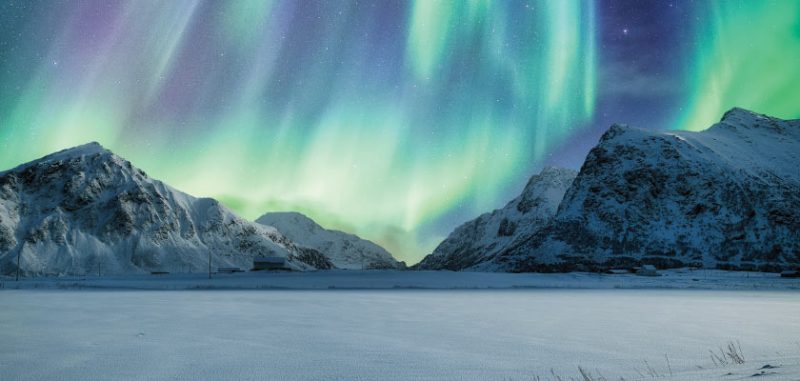
Trying to work out the best time of the year to see Northern Lights? In this month-by-month guide to the Aurora we share the best month to see Northern Lights and why.
We’ve all seen those wonderful photographs and movies of green lights dancing in the sky, which instantly fills us with a sense of awe that we wish to experience one day. The Aurora is a breathtaking sight to witness and one of the dreamiest things we could ever look at. Who wouldn’t love to experience that?
However, seeing the Northern Lights isn’t as simple as turning up and looking towards the sky. Lunar cycles, cloud cover, light pollution, sunlight and solar activity all play a role in when they appear to us.
In this month-by-month guide we clearly outline what the best time of the year to see northern lights is, so you can plan your vacation accordingly.
We’ll start with a quick overview of what causes the lights, so you understand how solar activity influences when northern lights appear. We’ll then go through each month, explaining how good it is for seeing northern lights, based on other environmental factors.
We’ll also tell you our recommendation for the best month to see Northern Lights and why (spoiler: there are two!).
By the end of this article, you will know exactly which month is best to book your Northern Lights trip, and be able to pick a date for your vacation with confidence.
What causes the Northern Lights?
Solar activity causes the northern lights.
If you time your Northern Lights vacation to coincide with a period of high solar activity, you have a much greater chance of seeing the lights.
We cover this topic is much greater detail in our scientific explanation of the Aurora Borealis article , but here is a quick rundown:
The Aurora is caused by particles emitted by the sun. As they approach Earth, these solar particles are drawn into the Earth’s magnetic field, and channeled toward the planet’s north and south magnetic poles. The solar particles then collide with molecules high in the Earth’s atmosphere, resulting in the delightful glow that we call Northern Lights. This explains why the Aurora is concentrated around the North Pole (Arctic) and the South Pole (Antarctic) only, in an area known as the auroral zone or auroral oval.
The year you travel makes a big difference
The sun’s emissions follow an 11-year solar cycle, which correlates with Northern Lights activity .
During the years of the solar cycle when solar activity is low, less solar particles are thrown at Earth, and therefore there is less auroral activity. During periods of high solar activity and geomagnetic storms, the Earth is barraged by solar particles, and the Aurora Borealis is at its brightest and most visible.
Therefore, the best time to see the Northern Lights in the solar cycle is during the years with high solar activity. This is not to say that you won’t see the lights during periods of low activity, but your chances of seeing them are lessened.
We have just entered Solar Cycle 25, and the years 2024-2026 are predicted to be peak years for seeing the Aurora. For more details, check out our Northern Lights 2020-2035 schedule to find out the best years for a vacation to see the lights.
How the best time of the year to see Northern Lights is determined (5 factors)
As many of you would know, the Northern Lights actually occur all year long. Yes, you heard that right, and we know exactly what your next question will be: Why can’t we see them all year long?
It’s because visibility of the Aurora Borealis is dependent on other environmental factors, too. Solar activity is just one part of the equation for seeing the Northern Lights. Cloud cover, sunlight hours, light pollution and moon cycles all have a large influence on aurora visibility.
Think about star gazing. The stars are always there, but the sky needs to be clear and dark to see them. The stars won’t be visible if the sun is still shining or there is cloud cover. You can’t see them near bright city lights, and you won’t see them as well during full moons. It’s the exact same for the aurora.
#1 Clear skies
To see the Aurora with your own eyes, you’ll need a clear night sky.
It is widely said that winter is the best season to see the Aurora Borealis because it is darker. True, it is darker in winter. However, what is said less often, is that in winter there is often heavy cloud cover, particularly from snow clouds.
I say this from my own personal experience, travelling to Finnish Lapland in January. The region was covered in snow cloud the whole time, and speaking with the Lappish locals they said that December-January is not a good time to see the lights because it is always cloudy. Funny how the things you read often don’t match up to local wisdom.
Some people think that the Aurora appears when the temperature drops. This is loosely true, in that colder nights tend to also be nights that you get clear skies. Or the other way around; when there are clear skies, the outside temperature drops lower because there are no clouds insulating the land from the cold. But apart from that, the temperature doesn’t actually affect the visibility of the aurora.
Of course, if the skies are clear, you’ll have a better chance of spotting them, but don’t always count on weather reports or historical weather patterns because you never know when you can get lucky. You also can’t plan a vacation around a daily weather report, unless you are lucky enough to have your own private jet to whisk you there at a moment’s notice, which is highly unlikely!
Your best bet is to spend more days in the region, to get a chance at a cloudless night, and travel on a month when cloud cover is less likely.
#2 Daylight hours
Although the Northern Lights occur for much of the year, there aren’t enough hours of darkness during the summer months to see them. As mentioned earlier, the Aurora occurs around the north pole and south pole. These are regions that also experience Midnight Sun, which means the sun does not completely set during summer or only briefly sets. In other words, it never gets really dark in Summer.
Summer = Midnight Sun = No/Little Darkness = No/Little Chance of Seeing Aurora.
Therefore, you should avoid the Summer months for your Northern Lights vacation.
The exception might be if you are more south where the midnight sun does not occur, and it is a period of high solar activity, such as in the northern US states. But the further south you travel, the less chance you have of seeing the lights since you are leaving the auroral zone. So, we wouldn’t recommend that as a good strategy for seeing the Northern Lights either. Maybe it’s ok if you already live in the region, but don’t plan an international vacation around it.
#3 Moon cycle
Like with star gazing, the cycle of the moon has a bearing on the visibility of the Northern Lights. A full moon will throw extra light into the sky, which you want to avoid if you can. For the most spectacular sight, try and plan your trip around a dark moon (new moon) when the sky is darkest.
#4 Light pollution from cities
When compared to cities, rural settings are preferable since they are less affected by light pollution. Like the moon, cities can also put quite a bit of light into the night sky, which will impact aurora visibility. Since light pollution is present all year round, the best thing you can do to avoid it is to stay in more secluded locations away from large cities .
#5 Brightness of the aurora
The brightness of the Aurora Borealis is determined by the amount of solar activity in the location, which is the rate at which solar particles collide with the Earth’s atmosphere. The best way to plan for this is to organize your Northern Lights vacation for a year of high solar activity and to keep an eye on aurora alerts. It is also said that the equinoxes (spring and fall/autumn) have more activity, so it is worth taking this into consideration.
What is the best month to see Northern Lights?
Best time of the year to see northern lights:.
These months fall around the spring and autumn/fall equinoxes, have mild weather and are not plagued by snow cloud. They also have a good balance of daylight and nighttime hours. Both are equally good for seeing the aurora borealis in our opinion. Exactly which month you choose depends on what else you like to do besides seeing the lights.
March: If travelling to see Northern Lights in March, there will still be snow on the ground from Winter. This is therefore a great choice if you like snow play or snow sports.
September: If you don’t like the cold or you enjoy photography, plan your vacation for September so you can capture the gorgeous autumn colors and the aurora reflected in the unfrozen lakes.
However, March and September aren’t the only good months to see Northern Lights. They are just our ‘best’ picks. Jump down below to read more about each month.
Northern Lights Monthly Planner
Since our readers are so intrigued, we’ve prepared a monthly calendar to help you plan a trip, so you too can experience the beautiful Aurora Borealis. Keep in mind this applies to the Northern Lights Aurora Borealis only (Southern Lights Aurora Australis will be the opposite).
Northern Lights in January
January, February and March are the most popular months for Aurora hunting since they bring long, dark nights and lots of snow to play in during the day while you wait for darkness to descend. While snow is fun, remember that snow inevitably brings snow clouds, which could impede your view of the lights.
January is a month of rebirth as the sun finally rises above the horizon, yet it may also be bitterly cold. This can be good or bad depending on your outlook; we think the idea of sitting under a cold sky and looking at the Northern Lights dancing in the sky is fun. But that’s not for everyone!
Your greatest enemy in January will be cloud cover. Spend a few extra days in the region to stay and play, to increase your chances of seeing the Northern Lights. Allow 4-5 days or longer.
Northern Lights in February
In February the days are substantially longer and the weather improves slowly in February. It is a good month to chase auroras, although you will still need to keep your eye on snow clouds. The nights are still very long giving good cover of darkness to view the aurora borealis, and there is lots of snow to play in. It’s a good month to travel if you enjoy doing snow sports and snow play, as well as Northern Lights watching.
Northern Lights in March
Best time of the year to see northern lights.
Temperatures begin to increase in March, but it can still be chilly, especially at night. The ground is covered in a deep, clean coating of snow, and because most of the winter snow has fallen, there are fewer snow clouds overhead to obscure the Northern lights in March.
It’s also suggested that the Equinoxes in the spring and autumn bring more solar activity. When you combine this with somewhat warmer temperatures and better weather (perhaps with less cloud cover), you may feel driven to go Aurora hunting in late March or early April.
The daytime hours will be extended by then, so be prepared for some later evenings. However, based on the advice of experienced aurora hunters and the balance of all the different environmental factors, we’d say that March is the best month to see Northern Lights .
Northern Lights in April
As mentioned for March, it is thought that the equinoxes bring more solar activity and more chance of seeing the Northern Lights. You should expect clearer skies now that it is well past the winter, however the days will be longer. It is a comfortable time of year to travel as the days are warmer, but you will quite likely be faced with muddy ground from the snow melt and possibly mosquitoes depending on where you are.
In early April there will still be a good number of nighttime hours, so the chances of seeing Aurora are still OK, but from this point onward the night hours will start to reduce greatly.
For example, in early April in Iceland you can expect a sunrise time of approximately 7am and sunset 8:30pm. In late April, the days are even longer. Therefore, if travelling in April, stick to the start of the month.
Northern Lights in May
In May we start to get very long days, and fewer nighttime hours. Dark skies are required to see the Northern Lights, and while the Aurora may be seen to scientific equipment from early April to late August, the sky is just too luminous for the human eye to observe the spectacle. May is not a great month to travel for Northern Lights, because there is too much sunlight.
In the Arctic regions in May, June and July, you should forget about seeing the Northern Lights because they are veiled by the Midnight Sun. It’s a beautiful time of year to travel otherwise, but not a good time to plan a Northern Lights vacation.
Northern Lights in June
June and July are the months of the Midnight Sun in Arctic regions. In these regions, don’t expect to see the Northern Lights in June, as there is too much daylight.
Northern Lights in July
As mentioned for June, this is a period of Midnight Sun. You won’t see the Northern Lights in July in Arctic regions because there is too much sunlight.
Northern Lights in August
Your greatest enemy for seeing Northern Lights in August continues to be sunlight hours. The days start to get a bit shorter from mid-August, but they are still very long. As for May, you should try and avoid this time of year for a Northern Lights vacation. If you are planning a Northern Lights vacation for August, then push it as far to the end of the month as you can.
Northern Lights in September
We would recommend the September and October month to anyone who wants to avoid the bitterly cold winter. We know that not everyone loves the extreme cold weather, so this is a good alternative if you are one of those people.
September ushers in a brief autumn, but the colors are breathtaking, and best of all, you can often view two Auroras for the price of one. How so? In most years, September and October are the only months the Northern Lights are visible when the lakes and rivers are ice-free.
The beauty of this is that you can frequently see the Northern Lights overhead and reflected on open water. If you’re a photographer, you don’t want to miss it. It’s a genuinely stunning picture that only stays around until the great freeze hits, the canals freeze and regions gets blanketed in the first snowfalls of the season.
Aim for late September, as this is closer to the equinox and will bring in some longer nights.
Northern Lights in October
Like September, this is a great month to travel. Early October is still quite close to the autumn equinox which is said to be a good time for auroral activity, and the days aren’t too cold yet. There is a good number of nighttime hours, and the winter snow and cloud cover has not arrived yet.
Photographers can get a glimpse of the Northern Lights reflected on the lakes and rivers before they freeze, which is a prize photo opportunity. However, October can start to usher in rain and storms, so be cautious of this if planning your aurora vacation around this time.
Try to plan your Northern Lights trip towards the start of October, to avoid the risk of rain, storms and early snowfall.
Northern Lights in November
November is a transition month, as it brings the first significant snowfalls of the season. It’s incredible to see how quickly the landscape changes; it’s as if autumn turns into winter virtually immediately. Although the snow brings a lot of cloud cover, the shorter days also offer darker skies, which extend the amount of time the Aurora may be seen.
October and November can be stormy, especially along the coast. Having said that, November is usually still a pleasant month to experience the Aurora.
Northern Lights in December
The weather begins to dry out in December. The snow not only creates the picture-perfect white Christmas and winter wonderland, but it also allows you to combine your Aurora Borealis hunt with other exciting activities. Keep in mind that during the coldest months of the year (December to early January), you may only have a few hours of daylight, with longer dawns and dusks.
It is also a time of heavy snowfall, so your view of the Northern Lights may be obscured by snow cloud. Your greatest enemy for seeing Northern Lights in December will be cloud cover. Plan a longer stay to maximize your chances of seeing the lights, taking your time to enjoy the other festive activities that are on offer at this time of year.
How long should your Northern Lights trip be?
For the best chance of seeing the Northern Lights, you will want to spend as much time as you can afford in the region. Allow longer if you are travelling during periods of lower solar activity or greater chances of cloud.
- Minimum: 4 days
- Ideal: 1 week
After speaking with locals in Finnish Lapland during my own Northern Lights vacation awhile back, they said we should allow at a minimum 4 days in the region but ideally 1 week to see the Aurora.
We only spent 2 nights in Lapland to see the lights, so it’s no wonder we didn’t see them on that trip. Hopefully you don’t make the same mistake!
Final Thoughts on The Best Time of the year to See Northern Lights
For anyone who doesn’t live near the Arctic Circle, seeing the Northern Lights is a once-in-a-lifetime opportunity. If this is on your bucket list and you want to organize your dream trip, we hope you have found this guide helpful. Personally speaking, I wished there was a guide like this when I was planning my Northern Lights trip several years ago, but there wasn’t, which is why I have created it for you.
In the end, unfortunately there is never a guarantee that you will see the lights. Afterall, we have no control over the weather variables. But you can plan your trip around those factors that can be predicted in advance. In particular, solar activity, time of year, and of course, the right location. You can read more about the best places in the world to see the Northern Lights in this article and the best countries in this article .
The best advice we can give is to stay as long as you can afford in the Arctic region, even if this means staying in cheaper accommodation instead of the fancy domes and igloos you see. I feel it is wiser to spend your money on a longer stay, rather than spend it all on 1-2 really expensive nights with your fingers crossed. The longer you spend there, the greater chance you will have of seeing the lights. Seriously, if there is nothing else you factor into your planning, make sure you spend at least 4 days in the Arctic region… and don’t travel in Summer!
With a bit of planning and allowing for a more extended amount of time in the region, you hugely increase your chances of seeing the Northern Lights for yourself.
Best Time of The Year to See Northern Lights | Article References:
- Responsible Travel https://www.responsibletravel.com/holidays/northern-lights-watching/travel-guide/when-to-see-the-northern-lights
Related posts:
- Best Place and Time to See Northern Lights 2020-2035
- Northern Lights Map | Where Northern Lights are in the World
What are the Best Years to See Aurora? Northern Lights Schedule 2020 to 2035
- How to Choose a Good Northern Lights App
Related Posts

How & When Does Northern Lights Happen? The Science
The Northern Lights are one of the most beautiful natural phenomena on Earth. But how and when does Northern Lights happen? What causes them and…

If you’re planning a vacation to see the Northern Lights, you should know that some years are better than others for seeing the Aurora. Choose…

Where’s The Best Place to See Northern Lights on Earth?
If seeing the Aurora Borealis is on your bucket list and you’re willing to go anywhere to catch them, then this is for you. In…

What are the Best Countries to See Northern Lights?
Seeing the stunning Aurora Borealis is a once-in-a-lifetime dream for most travel enthusiasts. However, what are the best countries to see Northern Lights remains a…

The northern lights stream down above Kirkjufell mountain in Iceland’s Snæfellsnes Peninsula.
7 Magical Places to View Auroras
These tips will give you the best shot at experiencing the enchantment of the northern and southern lights.
The otherworldly aurora borealis, or northern lights, begin high in the Earth’s atmosphere—at altitudes from 60 to more than 250 miles—when charged particles from the sun become trapped in the Earth's magnetic field. The result is a colorful, dancing light show.
The first time I filmed an aurora was from an icebreaker near Antarctica. Luckily, there are much more accessible places if you’d like to take in these light shows yourself.
For the best seats to this celestial scene, consider anywhere with a magnetic latitude above 55° and low light pollution. Find your magnetic latitude on NOAA and here .
In the polar latitudes, auroras can appear on any dark night. Long winter nights are good but not necessarily the best time. Near equinoxes in March and September, the Earth’s magnetic field lets more solar particles interact with the atmosphere, creating aurora seasons! I suggest autumnal equinox in September, when there are pleasant temperatures in polar latitudes. Find the dark hours of your location here , or by using a sky guide app.
And remember: Besides weather, a dark sky and the right season are the keys. Try moonless nights.
Even without the northern lights, Iceland is an otherworldly place to visit, with glaciers, geysers, massive waterfalls, and volcanoes. Both the latitude and longitude of the country favor aurora viewing, but the weather doesn’t always cooperate. However, a good coastline road around the country lets you chase clear skies.
I have seen my best auroras from Kirkjufell mountain on the west coast. In high activity you can even spy the northern lights from the suburbs of Reykjavík; the Grotta Lighthouse is a popular viewing spot.
Across the country, sky watchers can take in the dancing lights from outdoor hot tubs, inside Buubble lodges, and from hot spring lagoons.
When to Go: Late August to early April
Fairbanks, Alaska

In Fairbanks, Alaska, the sky glows with the aurora borealis.
Located just two degrees below the Arctic near international airport and close to the impressive Denali National Park , Fairbanks is the best place in the U.S. to take in the northern lights. It even has its own forecast system and offers tours to take visitors far from city lights.
When to Go: Late August to mid-April
Yellowknife, Canada

The aurora borealis spreads out above Prosperous Lake in Yellowknife, Canada.
This Northwest Territories capital on the shores of Great Slave Lake boasts its own Aurora Village and special activities for northern lights tourism.
Canada is an aurora viewing paradise, thanks to its northern latitude and low light pollution; elsewhere in the country, Wood Buffalo and Jasper National Park are popular viewing spots.
When to Go: Mid-August to late April. For Churchill and Wood Buffalo, early August to early May.
Tromsø, Norway

A fjord reflects the glowing green light of an aurora near Tromsø, Norway.
The largest urban area in northern Norway is 217 miles north of the Arctic Circle, but thanks to the Gulf Stream the coastline has surprisingly moderate temperatures. It also has beautiful scenery, magnificent fjords, and the Lyngen Alps .
I have seen spectacular auroras from the village of Ersfjordbotn, 12 miles from Tromsø. Other popular locations in the country are the Lofoten Islands and the far northern towns of Alta, Nordkapp, and Kirkenes.
When to Go: Mid-September to late March
Northern Sweden and Finland

The northern lights swirl over a wooded area in northern Sweden.
Sweden’s northernmost town of Kiruna is a gateway for nearby attractions. There is the ICEHOTEL, mountainous Abisko National Park , the local Sami culture , and plentiful reindeer. A short drive from the town takes you to a good spot for aurora viewing. The weather here is much more stable than the Norwegian coast, but it’s colder too.
In Finland’s Lapland region, Rovaniemi serves as a gateway town to nearby national parks —where in winter you can spot frozen snow-covered trees called Tykky sculptures along with the northern lights.
- Nat Geo Expeditions
When to Go : Mid-September to late March

Clouds partially obscure an aurora above an iceberg in northeastern Greenland.
It’s possible to be too far north to see the northern lights—such is the case in northern Greenland . But head farther south for beautiful auroras and attractions like Qaleraliq Glacier , which has small floating icebergs even in summer.
When to Go : Mid-August to late April in the south and late August to mid-April in Nuuk.
Tasmania and New Zealand

The southern lights illuminate the sky in Tasmania, Australia.
You hear about northern lights more often than southern lights (aurora australis) because there are fewer locations to see auroras from the Southern Hemisphere. Your best chance is on the southern tip of both Tasmania ( Australia ) and New Zealand , where a dark sky will help you see any active auroras over the southern horizon. These are the closest accessible places to the south magnetic pole, outside of Antarctica.
When to Go : Year round, but your best chances are near equinoxes.
Babak Tafreshi is a photographer and the founder of The World at Night (TWAN) photography program. Follow him @babaktafreshi .
FREE BONUS ISSUE
Related topics.
- NIGHT SKY PHOTOGRAPHY
- TRAVEL PHOTOGRAPHY
You May Also Like

2024 will be huge for astrotourism—here’s how to plan your trip

This Swedish overnight train takes you straight to the northern lights

5 spectacular ways to see the northern lights in Canada

9 spectacular night sky events to see in 2024

How to photograph the Northern Lights, according to an expert
- Environment
- Perpetual Planet
History & Culture
- History & Culture
- Mind, Body, Wonder
- Paid Content
- Terms of Use
- Privacy Policy
- Your US State Privacy Rights
- Children's Online Privacy Policy
- Interest-Based Ads
- About Nielsen Measurement
- Do Not Sell or Share My Personal Information
- Nat Geo Home
- Attend a Live Event
- Book a Trip
- Inspire Your Kids
- Shop Nat Geo
- Visit the D.C. Museum
- Learn About Our Impact
- Support Our Mission
- Advertise With Us
- Customer Service
- Renew Subscription
- Manage Your Subscription
- Work at Nat Geo
- Sign Up for Our Newsletters
- Contribute to Protect the Planet
Copyright © 1996-2015 National Geographic Society Copyright © 2015-2024 National Geographic Partners, LLC. All rights reserved

- Travel Trade
- About Explore Fairbanks
- Armed Forces
- Events Calendar
- Alaska Native Events
- Summer and Solstice Events
- Winter Events
- Submit Event
- Adventure/Ecotours
- Aurora Viewing
- Dog Mushing
- Fishing/River Excursions
- Flightseeing/Aviation
- Gold/Frontier History
- Hot Springs
- Nature/Wildlife Viewing
- Sightseeing
- Sports/Activities Rentals
- Winter Activities
- Art Galleries/Exhibits
- Classes/Lectures
- Alaska Native Culture
- Performing Arts & Shows
- Bed & Breakfasts
- Hotels/Motels
- Campgrounds/RV Parks
- Vacation Rentals
- Coffee & Sweets
- Breweries, Distilleries & Bars
- Casual Dining
- Fine Dining
- International Dining
- Bookstores/Maps
- Clothing/Sporting Goods
- Gift Shops/Specialty Goods
- Air Transportation
- Auto/RV Services
- Auto/RV Rentals
- Ground/Public Transportation
- Marine Transportation
- Copying/Printing
- Medical/Health
- Places of Worship
- Real Estate
- Associations
- Financial Services
- Industry/Economic Development
- Marketing/Promotions
- Publications/Publishers
- Travel Agents/Trip Planners
- Visitor Information
- COVID-19 Information
- Morris Thompson Cultural and Visitors Center
- Downtown Fairbanks
- University of Alaska Fairbanks
- Pioneer Park
- Family-Friendly Fairbanks
- Chena Hot Springs
- Alaskan Neighbors
- Aurora Tracker
- Aurora Viewing Locations
- Midnight Sun Tracker
- Winter Season
- Gold Rush History
- Arts & Entertainment
- River Activities
- Dog Mushing & Kennel Tours
- Team & Recreational Sports
- Hiking, Biking & Running
- Camping, Fishing & Hunting
- Wildlife Viewing & Birdwatching
- Local, State & National Parks
- Visitor and Winter Guides
- Insider Tips
- How to Dress for Winter
- Meet a Real Alaskan
- Transportation
- Cruise to Fairbanks
- Alaska Marijuana Laws
- The Downtown Antler Arch in 360
- The Centennial Pedestrian Bridge in 360
- Dog Sledding Tour in 360
- Snowmachine Aurora Tour in 360
- The Morris Thompson Center in 360
- Pedestrian Bridge in Winter in 360
- Murphy Dome in 360
- Midnight Sun Festival in 360
- Video Gallery
- Marketing Resources
- Itineraries
- Cruise/Land Tour Clients
- Airline Development
- EF Partner Resources
- FAMS Certified Expert
- General Information
- Meeting and Event Planning
- Planner Assistance
- Testimonials
- Meeting Planner Guide
- Press Releases
- Media Assistance
- Story Ideas
- Media Tours
- Morris Thompson Cultural & Visitors Center
- Activities, Attractions and Tours
- Local Military Discounts
- Tourism Employment
- Volunteer for the Visitor Industry
- Relocation Resources
- Housing In Fairbanks
- Privacy & Terms
- Partner Login
- What We Are
- Join Explore Fairbanks
- Sustainable Destination

Aurora Season
Fairbanks' renowned aurora viewing lures people from all over the world during Aurora Season. But why is Fairbanks, Alaska popular for viewing the northern lights and when should you visit? How do you look for the aurora and will you stay warm doing so? If you've thought of these questions, you’re not alone! Keep reading to have these frequently asked questions answered and get other useful information about this magnificent natural phenomena.
View the real-time Aurora Tracker
Northern Lights in Fairbanks
It's no surprise that with Fairbanks' location, it is frequently referred to as the best place to see the northern lights in Alaska, the United States and in many cases, across the globe.
There are many different ways you can hunt for the aurora. You can drive to a nearby vantage point and wait for them to appear, or take a tour and watch them from a heated “aurorium” cabin, yurt, dome or lodge. You can also see them on a dog sled adventure or while you are ice fishing, on a snow cat tour, via a trip part way up the Dalton Highway or even on a flight above the Arctic Circle.
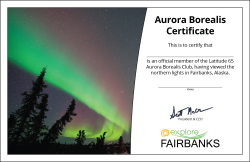
Aurora Viewing Map & Guide
Use the brand-new Aurora Viewing Map & Guide to plan your aurora viewing adventure in the Fairbanks area. In addition to an easy-to-use map detailing northern light vantage points, you'll find science information, pro tips for aurora chasing and FAQs.
While you're in Fairbanks, a printed copy can be picked up at the Morris Thompson Cultural and Visitors Center, local hotels or through tour operators.
Download the Aurora Viewing Map & Guide
View the wonder of the northern lights in Fairbanks with this short video!
Aurora viewing faqs, why is fairbanks such a great place to view the northern lights.
Fairbanks’ location is ideal for northern lights viewing because it is under the “Auroral Oval,” a ring-shaped zone over the far north where aurora activity is concentrated. Additionally, Fairbanks’ low precipitation and distance from coastal areas contribute to consistently clear nights. All combined these variables make the Fairbanks region an outstanding destination for possible aurora borealis viewing.
When is the best time to see the northern lights?
Fairbanks’ Aurora Season is from August 21 to April 21 and the aurora will be visible in Fairbanks an average of four out of five nights when the sky is clear and dark enough. Scientifically speaking, the aurora is dancing above year-round, but we can only see it during the Aurora Season when we have dark enough skies.
Am I going to see the aurora if I visit Fairbanks?
The northern lights are so prolific in the Fairbanks region and the Arctic that visitors who stay a minimum of three nights and are actively out during the late evening hours increase their chance of seeing the aurora to more than 90 percent!
How can I see the aurora?
There are so many different ways, but a great way is to take a northern lights tour with a guide. You can view them from a heated “aurorium” cabin or lodge, see them on a dog sled adventure, on a snow cat tour, via a trip part way up the Dalton Highway or even on a flight above the Arctic Circle. Or perhaps you want to go fishing while you wait and go on an evening ice-fishing adventure on a local lake! All of these are great options, or if you are a do-it-yourself adventurer, you can drive to a nearby vantage point and wait for them to appear. See below for accessible spots around Fairbanks.
What colors will I typically see on my visit?
Visitors will most typically witness a swirling array of green, teal, and white. An intense aurora can get a purple or magenta edge. The aurora takes on different shapes such as curtains, bands, rays and coronas.
What should I wear to go aurora hunting?
Layers, layers, layers and dress warmly! You will likely be out in the elements for extended periods of time. Rely on synthetic, wool, and fleece materials, especially in the winter. For more on how to dress for winter pursuits, watch this video.
In The Media

The Best Places (and Time) to See the Northern Lights
In Fairbanks itself, residents see the northern lights on about eight of every 10 nights. More

Northern Lights: 11 places to see the aurora borealis
The city of Fairbanks, in Alaska, is often cited as the best place to see the Northern Lights in the United States. More

7 Magical Places to View Auroras
Fairbanks is the best place in the U.S. to take in the northern lights. More

Best Places to See the Northern Lights
Fairbanks lies directly beneath a band of aurora activity, meaning from August to May, the town regularly experiences a celestial display of green, yellow, and purple. More
How to Photograph the Aurora
- Read this blog post with helpful tips and tricks from local guides.
- Locate a dark area with minimal light pollution. Point your camera at the northern sky and compose your medium-distance foreground with a fixed object such as trees, hills or a cabin.
- Use a digital camera with manual settings and a solid tripod.
- Use a remote shutter to minimize camera shake.
- Bring extra camera batteries and a flashlight or headlamp and dress for extended times outdoors.
- Manually set your camera on its highest ISO setting, widest focal point and lowest aperture.
- Expose each shot for approximately 5 to 10 seconds. Longer exposures will result in brighter images, but stars will streak and the aurora will soften. Short exposures may have sharper detail but dimmer images.
- Every aurora and camera is distinctive, so experiment with different settings and exposure times to get the best shot.
101 Dunkel Street, Suite 111 Fairbanks, AK 99701-4806 Telephone: (907) 456-5774 Visitor Guide Request: 1-800-327-5774 Email: [email protected] About Explore Fairbanks

Where and when to see the northern lights in 2024
Now is the perfect time to plan a northern lights trip

- North America
- Viewing from home
When to see the northern lights
Northern lights forecasts.
Nothing quite beats seeing the northern lights, or aurora borealis, in all their glory. But where and when can you see them?
Lucky for us the next few years are going to be the best for seeing the northern lights due to heightened solar activity as we approach "solar maximum" in the current solar cycle.
So if you are planning a trip to see the northern lights now is the time to do it. Not sure where to go? Here we have rounded up some of the best places to see auroras around the world.
Related: Aurora colors: What causes them and why do they vary?
The northern lights are created when energized particles from the sun slam into Earth's upper atmosphere at speeds of up to 45 million mph (72 million kph), but our planet's magnetic field protects us from energetic assault.
As Earth's magnetic field redirects the particles toward the poles the dramatic process transforms into a cinematic atmospheric phenomenon that dazzles and fascinates scientists and skywatchers alike. The southern lights, or aurora australis, are produced in the same way.
We asked Tom Kerss, astronomy, author and northern lights expert what three pieces of advice he would give to someone wanting to see the northern lights.
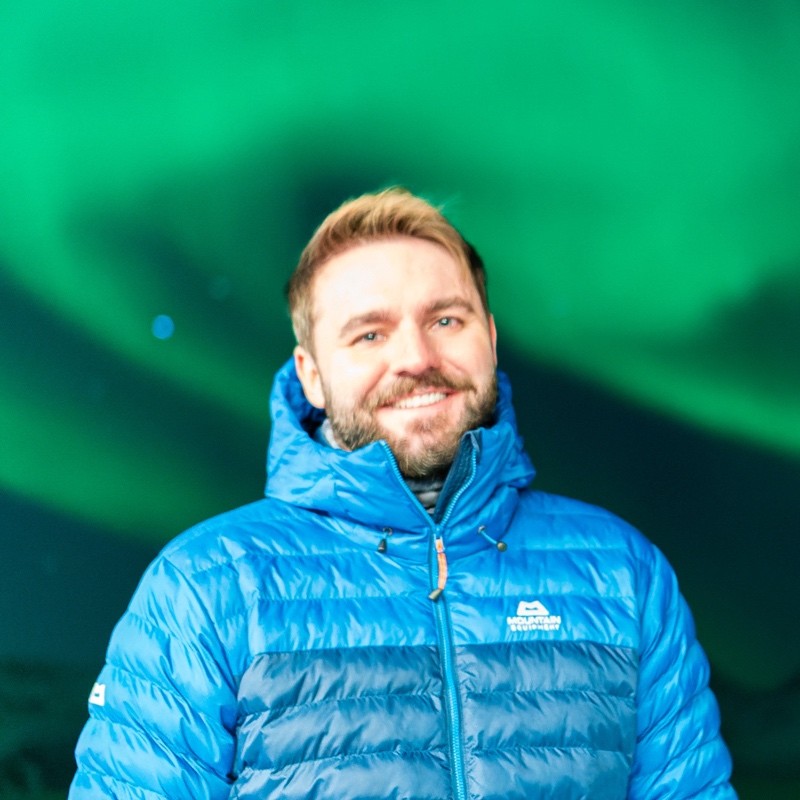
Tom Kerss is an astronomer and the author of numerous best-selling books about the night sky for both adults and children, including Northern Lights , Diamonds Everywhere and the Starry Stories Series .
What are your top tips for seeing the northern lights?
1. Unless you're lucky enough to have the lights come to you, seeing auroras is a matter of being in the right place at the right time. Fortunately, we can forecast where and when they are likely to become visible, so you can increase your odds. Being in Norway between late September and mid-March, during the darkest, moonless nights, and being mobile will greatly improve your chances.
2. It's important to persevere! The arctic nights can be extremely cold, but you'll need to push yourself and stay up late to make the most of the auroral zone. On good nights, the Lights are visible as soon as it gets dark, but you should try to stay up until after midnight.
3. Taking your own photographs of the Northern Lights is so alluring, and very rewarding. Today's cameras — including smartphones — capture super, colourful and clear shots. But try not to get too carried away. Make sure you absorb the luminosity, colour and subtle movement of the Lights with your own eyes. You'll make pictures in your mind that you can't share, but you can feel!
What is your favorite aurora fact?
My favorite fact about auroras is that they appear not only on Earth, but on many other worlds. Every planet in the Solar System (except Mercury) exhibits auroras, as do several moons and even a comet! Moreover, we've measured auroras on other stars, and possibly even exoplanets, and they can teach us about the environments and interiors of these remote worlds.
Where to see the northern lights in Europe
If you live in Europe, the easiest thing to do is head to the far northern parts of Norway, Sweden, Iceland and Finland. Many local people speak English in those regions and there are lots of tours available.
Wherever you plan on going, bear in mind that cloudy skies may make it difficult to catch auroras on any one particular night. If possible, leave yourself extra time to accommodate inclement weather.
Here is a list of some possible European northern lights trips and tour providers:
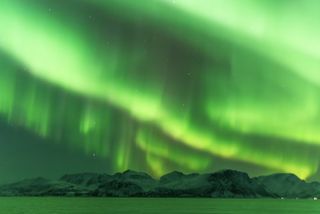
Hurtigruten Coastal Express
Bergen — Kirkenes — Bergen
Price: From £2942pp, includes breakfast, lunch and dinner + exclusive excursion to the Tromsø planetarium.
Duration: 12 days
Northern Lights Promise : If there is no recorded sighting of the northern lights while sailing, Hurtigruten will give guests a free 6- or 7-day Classic Voyage to redeem the following season. Terms and Conditions apply.
If you're interested in booking the Astronomy Voyage head over to Hurtigruten's official site .
If you're looking for the ultimate skywatching and cultural experience in Norway, we recommend taking the Hurtigruten Coastal Express along the stunning Norwegian Coast.
There are a number of voyages available as well as specialized " Astronomy Voyages " that include additional astronomy lectures from an onboard astronomer and a visit to Tromsø's impressive planetarium and science center.
You can read more about what it's like to experience the Hurtigruten Astronomy Voyage in our article .
The Northern Lights Company
The Northern Lights Company based in stunning Vesterålen, Norway, offers various 4, 5 or 7-night northern lights trips between September and April.
All tours include transport, accommodation, aurora chasing by night as well as daytime activities so guests not only get to see beautiful Norway but also experience it.
From eagle safaris and visits to the local Sami Reindeer farm to aurora research at the Andøy Space Centre and photography trips. There is something for everyone with the Northern Lights Company.
Visit Tromsø
Visit Tromsø sells aurora-watching trips around the city of Tromsø in Norway. The largest urban area in Northern Norway and the world's third largest city above the Arctic Circle, Tromsø lies just within the Northern Lights Oval, the region above Earth's geomagnetic North Pole where aurora displays are most likely to occur.
Visit Tromsø sells 'aurora chases,' dynamic night hunts for aurora displays in the aurora season between September and April, and slower-paced 'experiences' such as dog-sled and boat trips and overnight stays at aurora hotspots. Tromsø can be accessed by plane from Norway's capital Oslo; adventure seekers are sometimes rewarded by an aurora display during their incoming flight.
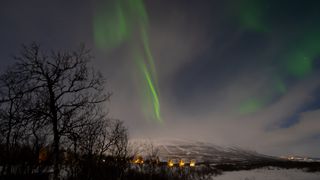
Lights over Lapland
Lights over Lapland sells a range of aurora-watching packages that take skywatchers to Sweden's northernmost region, Lapland. Lapland straddles the border between Sweden and Finland, with both sides offering excellent aurora viewing opportunities in winter months and the midnight sun experience in summer.
Lights over Lapland operates on the Swedish side of the border with most of its tours aiming for Abisko National Park (not far from the Esrange Space Center which runs rocket tests for ESA and is gearing up to perform the first satellite launches from continental Europe).
"Abisko has developed a reputation for being the No. 1 aurora-watching destination on the planet, due to the fact that it is located in a very special microclimate with less precipitation than any other location on Earth that is located within the aurora zone," photographer Chad Blakley, who is a co-founder of Lights over Lapland, told Space.com via email.
If you want to see what it's like to chase auroras in Swedish Lapland check out our article on what it's like to put Abisko's "cloud-busting weapon" to the test .

Guide to Iceland
Guide to Iceland sells a range of aurora-watching packages on the North Atlantic island, including bus tours, boat tours and hunting trips. Situated just below the Arctic Circle, Iceland provides a decent chance of catching the Northern Lights during winter months. If that doesn't work out, you can instead relax in the island's powerful natural hot springs and outdoor pools.
Viatour northern lights night tour from Reykjavik
Viatour operates evening aurora-watching trips from Iceland's capital Reykjavik. The bus tour takes tourists across the island to its most popular aurora spots. The operator says that those who don't get to see the northern lights during their trip can join again at no additional cost.
Arctic Adventures
Arctic Adventures offers a large number of tours from day trips to multi-day excursions to experience the very best of Iceland. There is a range of northern lights tours available whether it be traveling by bus, boat, or multi-day hiking tours. Experience the majestic northern lights with Arctic Adventures and make memories that will last a lifetime.
Where to see the northern lights in North America
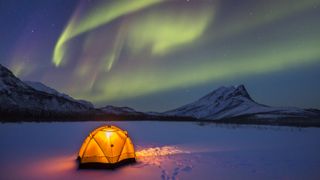
If you're interested in trying to photograph the northern lights check out our guides on how to photograph auroras , as well as the best equipment for aurora photography .
There are plenty of options for good aurora viewing in North America. While far-eastern Canada tends to be cloudy, the shore of the Hudson Bay, the northern Canadian towns of Yellowknife or Whitehorse, or the west coast of Alaska are usually good bets. (The city of Fairbanks itself can be a great choice for seeing northern lights without needing to go too far in the wilderness.)
Alaska Tours
Alaska Tours offers a range of packages from one-day trips to week-long tours that take visitors past the Arctic Circle to the heart of Alaska's wilderness, where the chance of catching the glowing auroras is among the best in the world.
Aurora Borealis Yukon
Aurora Borealis Yokon runs one-day to five-day aurora-watching trips in the Yukon territory in northwestern Canada. A direct neighbor of Alaska, Yukon offers pretty much the same aurora-observing conditions during the winter months.
Churchill Arctic Adventures
In the east, Churchill Arctic Adventures offers trips to Churchill, Manitoba, on the western shores of Hudson Bay. The company operates dedicated 'aurora domes,' heated cabins and other outposts in the boreal forest that allow visitors to observe the magnificent lights in perfect comfort. If the aurora doesn't show up, then perhaps some of the polar bears residing in this region may.
Can I see the northern lights from my home?
If you capture an amazing photo of the northern lights and would like to share it with Space.com and our news partners for a story or gallery, send images to [email protected].
The "standard" aurora borealis, observable in the Arctic regions, is generated by the solar wind , which constantly flows toward Earth. It manifests itself into a large "ring" above Earth's geomagnetic North Pole and is known as the aurora oval.
During times of heightened solar activity, the aurora oval can expand more southern latitudes. The National Oceanic and Atmospheric Administration (NOAA) Space Weather Prediction Center maintains a detailed 30-minute aurora forecast where you can see the predicted extent of the auroral oval and the probability of auroras. The aurora borealis is visible most nights, weather permitting, within a band several hundred miles wide that's centered at about 66 degrees north — about the same latitude as the Arctic Circle.
But geomagnetic storms, caused by coronal mass ejections (CME), can ramp up the northern lights considerably and make them visible over much wider areas. In early November 2023, for example, a powerful geomagnetic storm sparked auroras as far south as Greece and Turkey .
Related: Aurora myths, legends and misconceptions
As the solar cycle intensifies, such occurrences might become more common (or rather, slightly less rare). We recommend keeping an eye on Spaceweather.com for alerts of possible incoming geomagnetic storms as well as NOAA's Space Weather Prediction Center .
Yet even the most powerful geomagnetic storm will fail to deliver the experience unless other factors cooperate — a cloud-free sky, not too much moonlight, nighttime hours and absence of light pollution. (City-dwellers have to get out into the countryside for an aurora experience no matter how strong the geomagnetic storm supercharging the sky might be.)
But you can have an aurora experience without even leaving your house if you so choose. Our northern lights webcams article offers aurora views from some iconic locations from across Europe and North America, all in one place.
If you're planning an aurora-viewing trip, the best time is throughout the winter months. Anytime between late September to late March is a good time for northern lights hunting as the long nights provide ample aurora viewing opportunities.
The good news is that the sun's approximately 11-year solar cycle of solar activity is ramping up as we approach solar maximum. This means that the next few years will be the perfect time to plan a northern lights adventure.
The northern lights can appear for long periods or short bursts lasting only a few minutes (if that!) so the best way to see them is to wrap up warm, and wait. I have been on several northern lights hunts and sometimes they can appear when you least expect, so unless you're already outside and ready, you'll miss them completely. For me, the wait is all part of the experience, especially when you're out aurora hunting with other like-minded individuals. It provides the perfect opportunity to share aurora stories, do a spot of stargazing and simply enjoy the shared experience of the night sky .
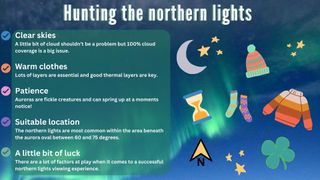
You can get an idea of how active the northern lights are likely to be in your area by keeping tabs on a short-term aurora forecast, such as the one provided by the Geophysical Institute . One predicting the next half hour is available on NOAA's Space Weather Prediction Website . Also, a citizen science website called Aurorasaurus gives on-the-ground instant information from aurora enthusiasts wanting to alert the community to new sky shows.
Join our Space Forums to keep talking space on the latest missions, night sky and more! And if you have a news tip, correction or comment, let us know at: [email protected].
Get the Space.com Newsletter
Breaking space news, the latest updates on rocket launches, skywatching events and more!

Daisy Dobrijevic joined Space.com in February 2022 having previously worked for our sister publication All About Space magazine as a staff writer. Before joining us, Daisy completed an editorial internship with the BBC Sky at Night Magazine and worked at the National Space Centre in Leicester, U.K., where she enjoyed communicating space science to the public. In 2021, Daisy completed a PhD in plant physiology and also holds a Master's in Environmental Science, she is currently based in Nottingham, U.K. Daisy is passionate about all things space, with a penchant for solar activity and space weather. She has a strong interest in astrotourism and loves nothing more than a good northern lights chase!
- Elizabeth Howell Staff Writer, Spaceflight
- Mike Wall Senior Space Writer
Early Star Wars Day Lego deal: $130 off UCS Razor Crest
Pre-Star Wars Day Lego deal: 20% off the Emperor's Throne Room
'Cat nights' are here as Leo, Leo minor, and Lynx constellations prowl the evening sky
- dcr66 To be honest I have never paid explicitly for some tours to see Northern Lights. They are more visible than you think and you just need to know when. I do know people that pay $$ to go see these things in Norway. Then I showed them the pics I took from a plane window. If you are flying from North America to Europe the great circle route usually takes you up to Greenland and Iceland. If the flight is night time, then get a window seat on the left side of the plane. Don't sleep and keep your eyes peeled when you are up there. Very likely you will see the green curtains easily up near the horizon. My daughter despite never seen them before saw it flying to Europe. Same can be done if your route takes you over Anchorage Alaska, the right side of the plane. I used to see it all the time on the fueling stopover to Anchorage AK back in the 80s and 90s. Less likely these days except on certain China based airlines. The polar route from North America to Asia that goes over the North Pole. You should be able to see the green curtains on either side when you are in the artic circle. The Prairies in Canada but avoid the summer because you will be in astronomic twilight essentially. I lived in Winnipeg for some years in the 1980s and I see them all the time. All kinds including the white sheet that cover the whole sky and bright enough to read. Reply
- michael'Buzz'collins Yes, luckily some only have to travel a short distance out to your back door! As Recently the Aurora Borealis, thankfully (no clouds 🙏)was able to be viewed in NW Donegal, Eire As I recently saw the repeat of Alexander Armstrongs Iceland visit on RTE ( as I missed it on ch5) So wasn't expecting to see this wonderful cosmic display!! Here are a few pictures that people took from their backyard from Burtonport to Buncrana, Inc Churchill, As I see another Churchill featured below in Manitoba as if seeing the Northern Lights isn't enough, it's program on Ch4/BBC has featured it as it has the most concentration of polar bears too (, because of the ice melting!) https://www.facebook.com/162517790452520/posts/pfbid031eTNJrFWY791rydpEhMDQDUyvGh3pnKZfgwKsK7VRTYwjGdSXZoTHaFdSfUvQNUVl/?sfnsn=mo https://www.facebook.com/1580520814/posts/pfbid033woQiJnL5XpYNoweeEznauNbSjQNJDxSSMxvzE7RxrrxoAwS7kbrTYPnDvZHKgBRl/?sfnsn=mo Simply outta this world,so to say😇 Reply
- View All 2 Comments
Most Popular
- 2 Highly precise atomic clocks could soon get even better. Here's how
- 3 Mars exploration, new rockets and more: Interview with ESA chief Josef Aschbacher
- 4 Everything we know about James Gunn's Superman
- 5 Sneak peek: Browncoats grab victory in Boom! Studios' upcoming 'Firefly: 'Verses' comic (exclusive)
When and Where to see the Northern Lights
The northern lights.
The northern lights are also known as the aurora borealis, meaning light of dawn. It’s said the term was first coined by Galileo in 1623 and is derived from ‘Aurora’, the goddess of the dawn and ‘Boreas’, the northern wind personified.

What are the Northern Lights?
The northern lights and their counterpart in the southern hemisphere appear when highly charged solar wind particles flowing from the sun collide with air molecules in the earth’s atmosphere transferring their energy into light. This occurs around the Polar Regions where those magnetic fields converge. These magnetic fields create auroral ovals around the top and bottom of our planet which move and distort as the earth rotates and solar flare activity increases.
They usually occur between 60 and 75 degrees of latitude, which covers northern parts of Canada, Norway, Sweden, Finland, Alaska and Russia as well as all of Iceland.
Interestingly, the northern and southern lights, or aurora australis, occur simultaneously but the inverse seasons mean they generally aren’t visible at the same time.
When is the best time of year to see the northern lights?
The aurora borealis are potentially visible under dark skies from late August to mid-April preferably under a clear, cloudless sky. While they occur year round they are weaker than sunlight and therefore sightings aren’t possible from May to July and for most of August.
- Spring and autumn generally provide more stable weather conditions and milder temperatures plus there is greater aurora activity around the equinoxes .
- November through to February offer the darkest skies and longer evenings for maximum sky-gazing.
- The strongest lights tend to appear between 9pm and 2am , though the best sightings often occur between 11pm and midnight.
- Between 4am and 5pm there is generally too much daylight to see the aurora – exceptions are the darkest months of the year and higher latitudes such Svalbard, where it is dark 24/7 from mid-Nov to end of Jan.
Why is aurora activity stronger around the equinoxes?
Due to the axial tilt, as the earth moves around the sun the angle of our magnetic fields relative to the magnetic field of the solar wind change. During optimum configuration, which occurs during the equinoxes, “magnetic cracks” open up that let solar particles in setting off an auroral storm cycle, which in turn creates a higher probability of northern lights.
Holidays & Inspiration
In our 40 years experience of arranging holidays to see the northern lights we’ve discovered the best places to view this incredible phenomenon.
Where is the best place to see the northern lights?
The northern lights most commonly occur within the geographic area beneath the auroral oval. It encompasses latitudes between 60 and 75 degrees and takes in Iceland, northern parts of Sweden, Finland, Norway, Russia, Canada and Alaska as well as southern Greenland.
The map graphic shown here is indicative of where the aurora are most visible, but they can appear at lower latitudes. Particularly strong solar storms can result in the lights being seen in Scotland and northern England, though most aurora activity occurs within the oval hence its designation.
However, aurora activity is not consistent and the auroral oval – the appearance of light as a ring around the poles – constantly shifts. Therefore strong aurora in Sweden do not necessarily mean strong aurora in Canada and vice versa. The oval is tracked by space weather stations and is shown in forecast modules (see the ovation map below).
Northern Scandinavia and Iceland offer the most accessible destinations from the UK for viewing the northern lights, but there are recognised locations throughout the zone that offer optimum conditions for sightings. It is important to be away from any sources of artificial light, such as street lighting, whereas you do want to be near open spaces offering big sky viewing.
Auroral Activity and Forecasts
Aurora forecasts are given for a 3-day period and are constantly updated. Longer term forecasts based on the 27-day solar cycle can be useful, but as with long term weather forecasts, they can change.
Recommended websites:
- Space Weather Prediction Centre , part of NOAA generate an animated ovation map depicting the auroral oval based on current solar wind conditions, which is updated every 30 minutes
- SpaceWeatherLive provides a useful 27-day forecast as well as the standard 3-day forecast
- University of Alaska show a daily aurora forecast showing the KP index for different regions
- Aurora Forecast is a useful resource from our trusted northern lights expert in Iceland, Sævar Helgi Bragason combining 3-day forecasts with cloud coverage.
- The Aurora Sky Station in Abisko, Sweden captures images every 5 minutes from their webcam
Follow us on Facebook for alerts when strong aurora are predicted.

The science behind the aurora
The solar cycle & solar maximum, the kp-index.
The sun is essentially a huge ball of self-luminous plasma which rotates every 27 days or so and surrounding the sun is a million-degree-hot atmosphere called corona. Sometimes there are large openings where the sun’s magnetic field stretches into space and these corona holes are the key to the northern lights.
Fast moving solar wind flows from these coronal holes, consisting of a stream of charged particles, which typically take 2-3 days to reach the earth – though this can be much faster following powerful solar flares or coronal mass ejections (CME) . The charged particles then collide with the earth’s magnetic field and accelerate down the magnetic lines towards the poles. Most are diverted and disappear into space, but the fast ones enter the earth’s upper atmosphere, where the magnetic fields converge. This is where the reaction of the particles and gases happen – atoms and molecules of oxygen and nitrogen get excited and release the light we know as the northern lights. Indeed, the event occurs simultaneously in the southern hemisphere causing the southern lights ( aurora australis ) to appear with one mirroring the other.
Approximately every 11 years or so, the sun’s magnetic field runs through a cycle of activity correlating to the number of sunspots on the surface. At the start and end of the cycle there are fewer sunspots, which is known as Solar Minimum , while in the middle of the cycle, known as Solar Maximum , the number of sunspots are at their most , finally returning to Solar Minimum to complete the cycle.
The Solar Cycle helps scientists to predict the likelihood of aurora activity, with solar flares and coronal mass ejections also increasing during the cycle. Solar maximum is generally regarded as the better time for viewing the northern lights as there is more activity. However, during the calmer period of solar minimum, corona holes can be long-lived. In other words, the sun is always emitting solar wind so auroras continue to be visible throughout the entire 11-year cycle solar cycle .
Our advice is not to get too focused on which part of cycle we are in as there are too many other variables including weather and cloud cover. As long as you’re within the auroral oval on a clear night between September and April, you can potentially witness the northern lights. That said, it’s hard not to get excited by the buzz around the current Solar Cycle #25 , which started in 2020. Many scientists are reporting that this solar cycle could be one of the strongest on record, a prediction being played out with incredibly strong auroras in 2023.
The Kp-index measures magnetic disturbances caused by solar wind ranging from 0 (low activity) to 9 (intense storms underway). The Kp-index doesn’t describe how the aurora will appear, but it gives a good idea of the activity forecast for the location you’re interested in and especially when you are actually in that location.
For instance, looking at both the Kp-index and weather forecast may help planning your evening activities over your break. Even a Kp index of 2 or 3 can produce beautiful auroras, but it gets exciting at 4 and above!
Frequently asked questions about the northern lights
The colour of the aurora depends on which chemicals are present and the altitude of the meeting of atoms and particles. The most frequent colour seen is green, caused by oxygen typically around 100 km high Red is more rare and harder to see, also caused by oxygen and higher altitudes (between 200-400 km). The purple and blue colours are caused by ionised nitrogen and occur at much lower altitudes. If all the colours mix together they appear as white (or if the lights are very dim). Displays can vary in intensity – from a glowing curtain of greenish yellow lights, dancing in the distance to a spectacular, multi-coloured fusion stretching across the sky. Most people lucky enough to see the aurora witness a display of green lights but if you are really lucky then that display might be yellow and red, or even multi-coloured. The differences depend on two main factors: what type of gas is reacting with the solar particles and at what altitude this activity is taking place. Most of it occurs 100-200 km above the Earth – a level where ‘excited’ nitrogen atoms glow green and blue. And above 200 km, oxygen atoms glow red when reacting with charged particles from the sun.
The colour of the aurora depends on which chemicals are present and the altitude of the meeting of atoms and particles.
- The most frequent colour seen is green , caused by oxygen typically around 100 km high
- Red is more rare and harder to see, also caused by oxygen and higher altitudes (between 200-400 km).
- The purple and blue colours are caused by ionised nitrogen and occur at much lower altitudes.
- If all the colours mix together they appear as white (or if the lights are very dim).
Displays can vary in intensity – from a glowing curtain of greenish yellow lights, dancing in the distance to a spectacular, multi-coloured fusion stretching across the sky. Most people lucky enough to see the aurora witness a display of green lights but if you are really lucky then that display might be yellow and red, or even multi-coloured.
The differences depend on two main factors: what type of gas is reacting with the solar particles and at what altitude this activity is taking place. Most of it occurs 100-200 km above the Earth – a level where ‘excited’ nitrogen atoms glow green and blue. And above 200 km, oxygen atoms glow red when reacting with charged particles from the sun.
There is a huge amount of activity that goes on during the aurora and all of the forces reacting cause constant shifts and flows which look like the aurora is dancing as it travels along the currents of the atmosphere. Sometimes the displays are delicate and subtle – strands of phosphorescent green flirting with the stars – or you might see the northern lights in full flow when rippling banners of green and red pulse overhead. Seeing the dancing aurora is one of the most magical parts of a northern lights show and you will be utterly transfixed.
There is a huge amount of activity that goes on during the aurora and all of the forces reacting cause constant shifts and flows which look like the aurora is dancing as it travels along the currents of the atmosphere.
Sometimes the displays are delicate and subtle – strands of phosphorescent green flirting with the stars – or you might see the northern lights in full flow when rippling banners of green and red pulse overhead.
Seeing the dancing aurora is one of the most magical parts of a northern lights show and you will be utterly transfixed.
The phases of the moon don’t affect aurora activity, but the moonlight can reduce the intensity of the displays especially to the naked eye. It is often suggested that a full moon should be avoided due to higher light concentration, however witnessing the moon against a sky of dancing aurora can be a magical experience. The lunar light can also benefit photographic opportunities in helping to illuminate subjects on the ground. During a new moon the sky is darker, given the perception of more intense displays, but of course the true determining factor remains with aurora activity on any given night. Lunar phases therefore only matter according to personal preference.
The phases of the moon don’t affect aurora activity , but the moonlight can reduce the intensity of the displays especially to the naked eye. It is often suggested that a full moon should be avoided due to higher light concentration, however witnessing the moon against a sky of dancing aurora can be a magical experience.
The lunar light can also benefit photographic opportunities in helping to illuminate subjects on the ground.
During a new moon the sky is darker, given the perception of more intense displays, but of course the true determining factor remains with aurora activity on any given night. Lunar phases therefore only matter according to personal preference.
Yes. Most commonly the aurora seen will be green or whitish, but depending on the strength of the activity, pinks and reds are also visible to the naked eye. The sensitivity of a person’s eyes will also be a factor. Photographs bring out the colours with more intensity so even weak aurora can look impressive through the lens. In fact, sometimes when the activity is weak or only just beginning it’s hard to tell if you are seeing wisps of cloud or the aurora. In this instance, taking a shot on your camera is the best way to confirm as the colours will show – don’t worry about focus, just use a long exposure for this test.
Yes. Most commonly the aurora seen will be green or whitish, but depending on the strength of the activity, pinks and reds are also visible to the naked eye. The sensitivity of a person’s eyes will also be a factor.
Photographs bring out the colours with more intensity so even weak aurora can look impressive through the lens. In fact, sometimes when the activity is weak or only just beginning it’s hard to tell if you are seeing wisps of cloud or the aurora. In this instance, taking a shot on your camera is the best way to confirm as the colours will show – don’t worry about focus, just use a long exposure for this test.
Discover Our Way

- First hand knowledge on tap
- Plan your trip with your own travel specialist
- We offer flexibility to suit you
- Feefo Platinum Service Award
- We'll help you find the right:
- Accommodation style
- Ways to travel
- You set the pace
- 24/7 in country support and guidance
- Full financial protection
- Travel disruption support
- Our flexibility promise
- View Our Guarantee »

Northern lights cruises: A guide to chasing the aurora borealis at sea

Witnessing the elusive northern lights flickering across the sky might cause you to gasp because it's actually that cool. The colorful ribbons of green look like something from outer space — and they are. Auroras appear when charged particles collide with Earth's atmosphere.
Seeing the ethereal display, also known as the aurora borealis, is a bucket-list experience for many travelers. Cruise ships can take you to destinations where your chances of catching Mother Nature's special light show are improved.
For cruise news, reviews and tips, sign up for TPG's cruise newsletter .
Remember that seeing this phenomenon doesn't involve a cruise director flipping on a switch. Witnessing the northern lights requires clear and dark skies, late-night viewing hours, enough solar activity for the colors to appear and a big dose of luck. Keep that in mind before you invest all your cruise vacation hopes in this one experience.
Where can I see the northern lights on a cruise?
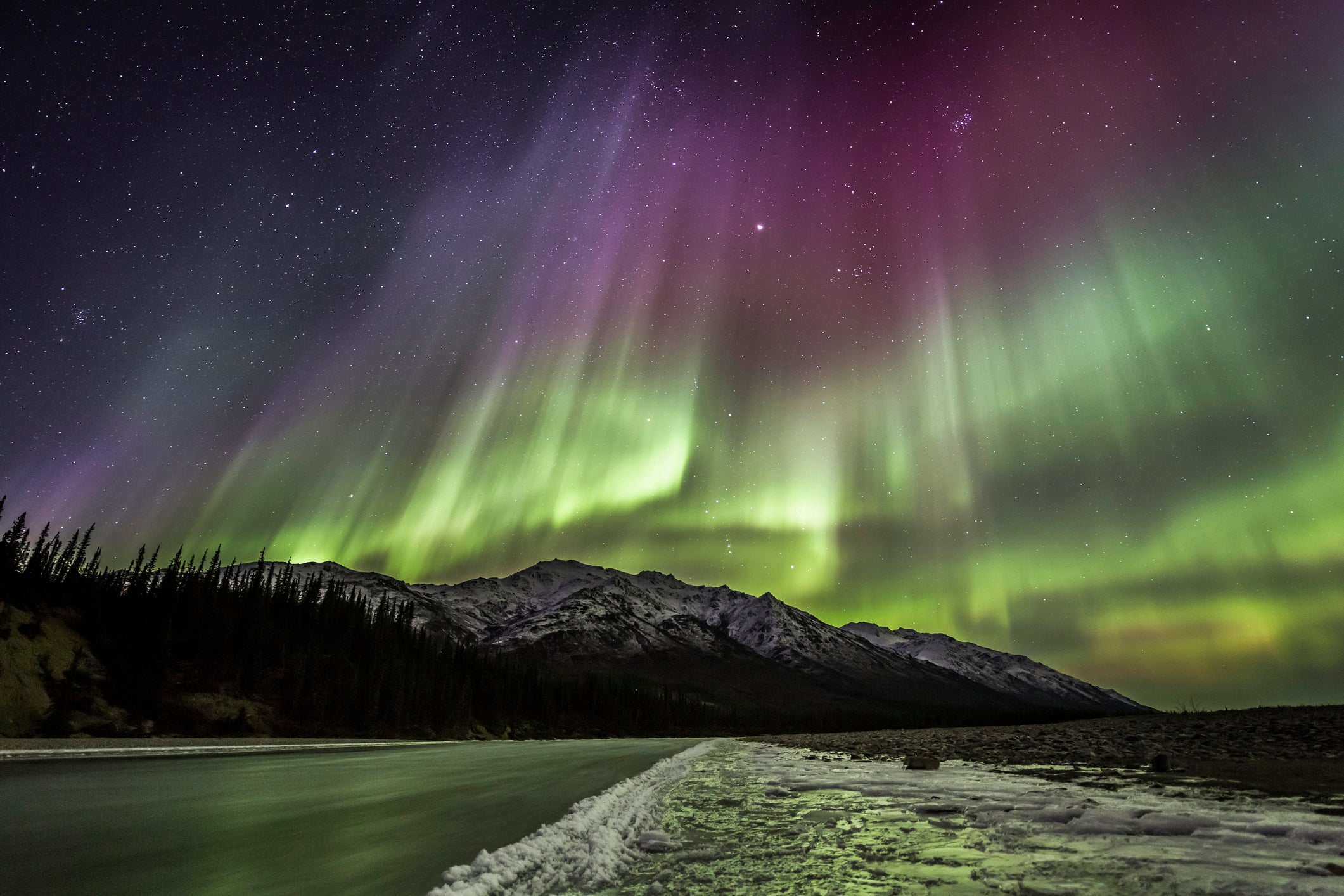
The lights are best viewed in the Northern Hemisphere and especially in locations on the so-called auroral oval, a ring zone over the polar regions. In cruising terms, that means prime viewing is in northern Alaska (which is easily accessible on cruisetours), Norway, Iceland, Arctic Canada and parts of Greenland.
Just off the auroral ring is the rest of Alaska. If you are on a cruise in the Inside Passage before April 21 or after Aug. 21 and are willing to be awake in the middle of the night (the lights tend to appear in Alaska after midnight), there's a chance you'll see the aurora borealis.
Cruise lines operating in Alaska — including Holland America , Princess Cruises and UnCruise Adventures — have northern lights sign-up sheets so you don't have to stay up all night, every night, hoping to see the display. Put your name on the list, and you'll receive a wake-up call or knock on your cabin door if there's aurora action. Plan to put on your clothes or bathrobe quickly, as the lights might only appear for a few minutes. (They could also last considerably longer.)
Related: Peak solar activity is forecast for 2024: Here are the best places around the world to see the northern lights
If you're interested in where to see the northern lights outside Alaska, the Arctic city of Alta, Norway, calls itself "The City of Northern Lights."
Alta's credentials include the world's first permanent observatory for viewing the aurora borealis; it was built there in 1899. A whole industry has sprung up around the lights, including such extravagant shore excursions as an overnight in a tent with viewing windows at a Sami dog-sledding camp. Alta is also home to the Northern Lights Cathedral, an architectural landmark.
Tromso is another Norwegian destination known as a hub for aurora borealis viewing. In late January, there's a northern lights arts festival featuring top artists in various musical genres.
Cunard Line and Hurtigruten are among the lines that visit northern Norway in the fall. However, the peak viewing season is from November to March (see below). Viking also visits but in the winter.
Iceland, Greenland and Arctic Canada appear on many expedition ships' itineraries during northern lights season, mostly early in the season in August and September. Lines with ships there include Quark Expeditions, Aurora Expeditions and Lindblad Expeditions.
When can I see the northern lights on a cruise?
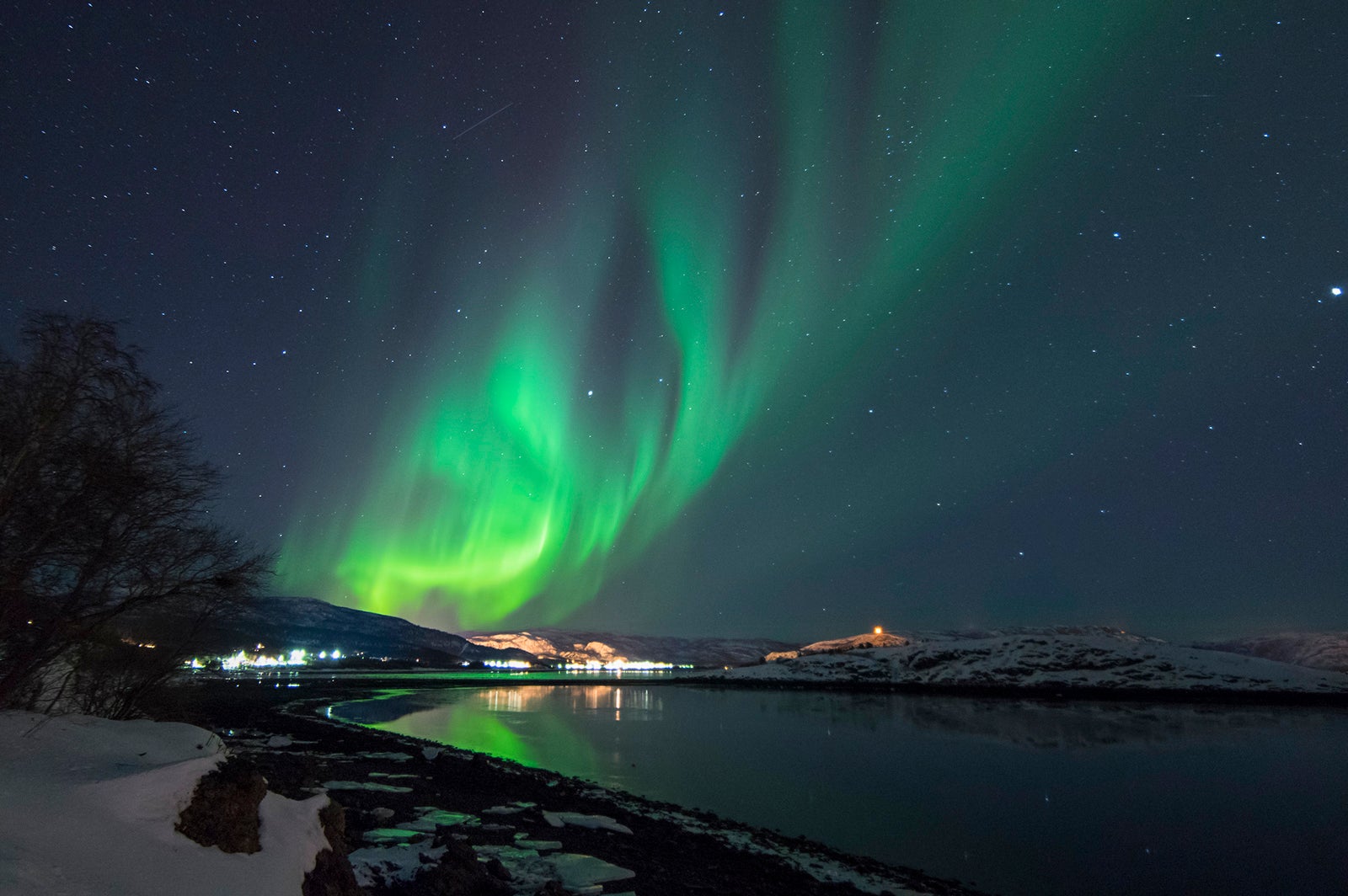
Because of the late-setting and early rising midnight sun, it's way too light during the summer to see the northern lights in the destinations mentioned, but solar activity does take place year-round.
If you have a goal of seeing the aurora borealis in any of the destinations discussed here, you're best off booking as far into the fall as you can find a cruise. Norway is the only prime northern lights destination with winter cruises.
The lights like to appear in the wee hours — particularly between 11 p.m. and 3 a.m. — in Alaska. An advantage in Norway is that it's dark enough to see them for a longer period during fall and winter.
Do cruisetours in Alaska improve my chances of seeing the lights?
Cruisetours in Alaska can improve your odds of seeing the aurora because they get you to Fairbanks and other inland destinations in Alaska that tend to have more cloud-free skies than in the Inside Passage, where cruise ships sail.
While you might see the lights from Denali National Park and Preserve during the viewing season, venturing to Fairbanks and points farther north will increase your odds.
Fairbanks tourism folks like to brag that if you visit for at least three nights between Aug. 21 and April 21, your chances of seeing the aurora borealis are more than 90%. (That assumes you are out actively looking during the late evening hours.)
Since your cruisetour might not visit for three nights, consider booking extra hotel nights before or after your cruise. Other things to do in this laid-back city (human population: about 100,000; moose population: 16,000) include riverboat tours, gold panning and yoga with reindeer.
You can also see the lights in Canada's Yukon Territory, including in the gold rush town of Dawson City, which is visited on some Holland America cruisetours.
Related: What's the best way to view the northern lights? We tried to see them by air, land and sea
Should I go on a cruise just to see the northern lights?
Yes, but remember that the phenomenon is dependent on the weather (clear skies required) and hard to predict, despite scientists' best efforts.
Viking has wintertime cruises to Norway from London specifically designed to track the lights in the Norwegian Sea during the peak viewing season — throughout the cruise but especially above the Arctic Circle in Tromso and Alta (where the sailings stop overnight). It's dark in these locales in winter, increasing your chances.
Hurtigruten is so invested in its northern lights experiences that it has hired famed northern lights astronomer Tom Kerss as its "chief aurora chaser." He will serve as an onboard expert, offering talks and workshops for passengers.
The line is so sure you will see the lights on the October-through-March sailings of its year-round 11- and 12-day Norwegian Coastal Express itineraries that the company has a guarantee called the Northern Lights Promise. If the deck's officers don't announce to all on board that the northern lights are happening, you can get a six- or seven-day Norwegian Coastal cruise for free.
Planning a cruise? Start with these stories:
- The 5 most desirable cabin locations on any cruise ship
- A beginners guide to picking a cruise line
- The 8 worst cabin locations on any cruise ship
- The ultimate guide to what to pack for a cruise
- A quick guide to the most popular cruise lines
- 21 tips and tricks that will make your cruise go smoothly
- 15 ways cruisers waste money
- The ultimate guide to choosing a cruise ship cabin
- Brochure Request
- Travel Advice
- Our Other Brands
- All Holidays
- Destinations
- About The Aurora
- Mythology of the Northern Lights
- Our Northern Lights hunting Formula
- Our Northern Lights Blogs
- The Science of the Northern Lights
- Working for us
- Our Expert Team
- Our Partners
- Financial Protection
- Responsible Travel
- Trip Preparation
- Frequently Asked Questions
- Why Book With Us?
- Customer Reviews

When is the best time to see the Northern Lights?
Home » About The Aurora » The Science of the Northern Lights » When is the best time to see the Northern Lights?
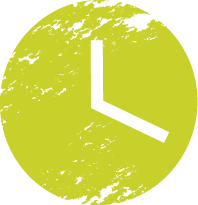
If we could answer this question we would be rich beyond the dreams of men!
As a naturally occurring phenomenon, the appearance of the Northern Lights is notoriously difficult to predict any further in advance than about two hours before it happens. So much is dependent on solar activity and, whilst we can estimate the number of sunspots that might occur on the sun, we can accurately predict neither when they will occur nor how frequently.
The best we can do is to provide a rough guide based on certain timescales.
Top image credit: NASA/SDO/AIA/Goddard Space Flight Center
The Solar Cycle - Solar Maximum/Solar Minimum
Our Sun goes through an activity cycle that lasts approximately 11 years and sees it pass through Solar Maximum (highest solar activity) and Solar Minimum (lowest solar activity). The Northern Lights are more prevalent during Solar Maximum, the last of which occurred in June 2014.
Generally speaking, the Aurora Borealis will remain very active for two to three years either side of Solar Maximum which effectively means we’re heading into the period of maximum activity.
There is further research to suggest that more significant solar events occur in the declining period following Solar Maximum which increases your odds of seeing a display from our destinations.
The main factor in determining the colours of any given display is the altitude at which the solar particles collide with gases in our atmosphere. Different gases prevail at different altitudes and in varying concentrations and it is the collision which “excites” these gases that determines the colour of the Aurora.
When observing the Aurora with your naked eye, the colours will differ slightly from the image that a digital camera captures. A digital camera can take a long single image exposure of the Aurora and therefore capture a lot more data in the darkness, much more than our eyes capture. This means the images captured are generally a lot more colourful than what we see with the naked eye.
Image credit: NASA/SDO
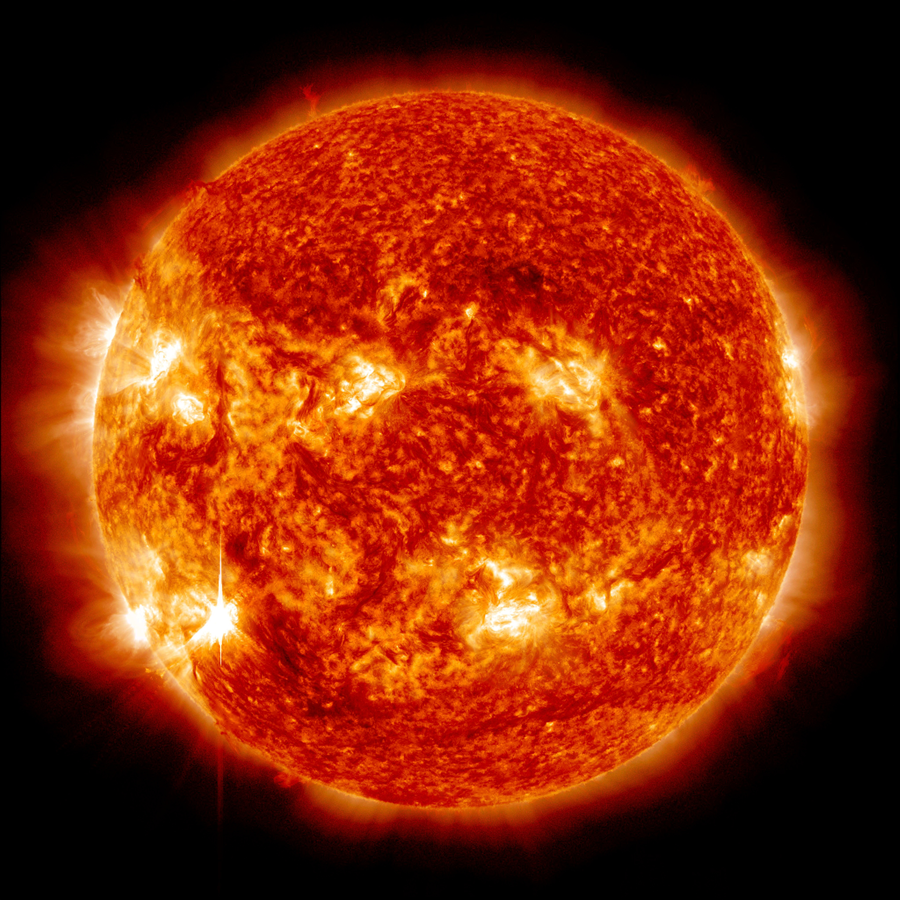
Learn More About Northern Ligthts
Where is the best place to see the northern lights, why are the northern lights sometimes coloured differently, how likely am i to see the northern lights, the aurora oval & the ovation map, what is the solar maximum, how do the northern lights appear, does a full moon ruin your chances of seeing the aurora borealis, aurora zone, aurora specialist, sign up to our northern lights insider.
Check your inbox or spam folder to confirm your subscription.
- Aurora knowledge and experience
- Unique holidays, in the very best destinations
- Expert guides – exceptional local knowledge
- Advice and guidance every step of the way
Comprehensive
- We include more in our holidays than any other Aurora operator
- Price Comparison guarantee
- No ‘from’ prices, everything you see is included in the price
- No hidden extras
Independent
- Proudly Independent
- The original and still the only dedicated UK Northern Lights tour operator
- Personal, hands-on service
- Fair and sustainable work ethos
- ATOL and ABTA protection available
- Over 20 years’ experience
- Our customers rate us 4.9/5 stars
- Award-Winning: Best Travel Company to Northern Europe 2023
- Search Search Please fill out this field.
- Current Issue
- Give a Gift Subscription
- Manage Your Subscription
- Sweepstakes
- Nature Travel
When and Where to See the Northern Lights in the Midwest
Nope, you don't have to trek to the Arctic Circle. When the conditions are right , you can see the northern lights right in our region. Here's how.
Lia Reichmann is an editorial apprentice at Midwest Living. She grew up in the western suburbs of Chicago before moving to Des Moines to attend Drake University. She is currently a senior studying multimedia journalism and history and is the editor-in-chief of the student newspaper, The Times-Delphic. When not busy working, you can find her relaxing with her fur baby, Athena, a gray tabby cat.
You don’t need to travel across the world to Finland or Norway (or even very far north in Minnesota) to see the northern lights. You can actually see them across much of the Midwest and look above as vibrant colors streak across the night sky. People in states like Michigan, Minnesota and Wisconsin may have a better chance to see the phenomenon; it’s all really a game of numbers and luck. You can increase your chances by following aurora forecasts from the National Oceanic and Atmospheric Administration. Helpful apps like My Aurora Forecast will also notify you when chances are good near you. Here is everything you need to know about the northern lights.
Getty Images
Where can I see the northern lights in the Midwest?
The best places to see the northern lights are in the auroral zone—a 1,500-mile radius of the north pole. But during geomagnetic storms (more on that below), this fantastical light display can move southward and be visible throughout the Midwest. Those in North Dakota, Minnesota, Wisconsin and Michigan have the best chances, but this magical event has even been seen around Des Moines, Cleveland and Chicago. Regardless of where you are in the region, if conditions are right—a clear and cloudless night with little light pollution and strong amounts of geomagnetic activity—you may be able to catch this otherworldly cosmic event.
Julia Sayers Gokhale
When is the best time to see the northern lights?
Sounds obvious, but you need darkness to see the northern lights, so people planning trips to prime locations in the auroral zone have to avoid summer, when the sun barely sets. Luckily, Midwesterners get to enjoy a longer northern lights season and can search the night sky for them from August until mid-April. But even for us, with fewer hours of daylight and a darker night sky, winter is the ideal time to go northern lights hunting.
How do I know when the northern lights are happening?
It may be the luck of the draw to see the northern lights, but there are tools to help. Scientists use a 0-to-9 scale called the Kp index to rank auroral activity; a Kp rating of 4 or higher is a good indicator of seeing the northern lights. You can check the NOAA Space Weather Prediction Center website for daily aurora forecasts or the University of Alaska Fairbanks' Geophysical Institute guide for viewing auroras . For Midwest-specific northern lights forecasts, Soft Serve News is a go-to for aurora enthusiasts and provides alerts about new northern light shows. Or even better, download the My Aurora Forecast app to your phone. It’s user-friendly and will ping you when the conditions are good near you. After installing the app, Midwest Living travel editor Julia Sayers Gokhale saw the northern lights twice in one winter— once in northern Minnesota (where she knew there could be a good chance), and a second time in Des Moines (a total surprise). After receiving the notification, she traveled 20 minutes northwest of the city to Jester Park, a county park, where she captured the photo above.
To optimize your chances, if the Kp index is high, drive to a spot away from city lights with a clear view of the horizon, then look north. And keep in mind, on any given night, the best window is between 10 p.m. and 2 a.m. While an aurora is a sporadic phenomenon, it usually occurs every two hours, with 15- to 30-minute periods of activity.
What are the northern lights, anyway?
The northern lights, also known as the aurora borealis, are a captivating celestial event that occurs when energized particles from the sun, called solar wind, collide with gasses in Earth’s upper atmosphere. These collisions create tiny flashes of colorful light and as billions of these flashes occur they appear to “dance” in the night sky. Earth’s magnetic field keeps us at the surface safe, while redirecting these particles towards the two poles.
Those magnificent colors seen high above come from multiple factors including the chemical composition of Earth’s atmosphere, the altitude where the aurora occurs and the density of the atmosphere itself.
The northern hemisphere calls this phenomenon the northern lights (aurora borealis), while in the southern hemisphere, it's called the southern lights (aurora australis).
- Search Please fill out this field.
- Manage Your Subscription
- Give a Gift Subscription
- Sweepstakes
- Nature Travel
10 Best Places to See the Northern Lights Around the World
From the U.S. to Scandinavia, these are the best places to see the northern lights.
To see the northern lights, unsurprisingly you'll want to go north. Caused by charged particles from the sun colliding with atoms in Earth's atmosphere, the lights form an "auroral oval" over the geomagnetic North Pole, so they occur most frequently in any area within approximately 1,500 miles of the pole. They're most easily viewed when skies are clear and dark, free from light pollution from cities and the moon. That makes Alaska and parts of Canada, which have long nights and ideal auroral latitudes, safe bets for viewing.
Americans in the lower 48 shouldn't despair, however; strong solar winds can sometimes result in the aurora appearing farther south. Hey, it's even been spotted in Atlanta. The dazzling natural display can be experienced in a variety of locations across the globe. Towns in Europe and North America market the lights as a tourist attraction, offering experiences for adventurers and luxury travelers alike.
From Churchill, Canada, to the vast Finnish Lapland and one rather unexpected U.S. destination (spoiler: it's in Pennsylvania), here are the absolute best places to see the northern lights.
Fairbanks, Alaska
The bitter cold that often comes with chasing the aurora can be a real deterrent, but what if you could see the lights while soaking in a natural hot tub? Enter Fairbanks' Chena Hot Springs Resort , whose boulder-enclosed lake offers the opportunity to enjoy a warm soak along with the light show. Fairbanks lies directly beneath a band of auroral activity, meaning from August to the end of April the town regularly experiences a celestial display of green, yellow, and purple.
The phenomenon is most frequently seen between 11 p.m. and 2 a.m., but the early-to-bed crowd need not worry. Chena Hot Springs Resort guests can request a wake-up call when the aurora is spotted in the sky.
Norway has no shortage of prime vantage points. First and foremost is Svalbard, a string of Arctic islands midway between continental Norway and the North Pole. Because the archipelago experiences polar night, or perpetual darkness, between mid-November and February, it offers visitors double the opportunity to see the lights and is the only inhabited place in the world where you can experience the phenomenon during the day. Join a three-hour snowcat safari or brave the cold on a snowmobile tour complete with a stop for warm drinks and biscuits.
Tromsø is northern Norway's largest city and is situated in the middle of the auroral oval. The city offers visitors a wide variety of tours to choose from during its dark season from late September through late March. One fun way to see the auroral display is to ride a cable car up Mount Storsteinen, which provides one of the best views of the northern lights in the city. Or, if you prefer to experience the magic while sipping Akvavit, slide into a table at the Skybar at Clarion Hotel The Edge .
T+L Backpack Quiz
North of the Arctic Circle in Finnish Lapland, surrounded by towering pines, is a surreally beautiful place to experience the aurora. We recommend dozing off while watching the dancing display from within a glass igloo at the romantic Kakslauttanen Arctic Resort . In addition to rooms made of wood or glass, there's also a traditional log house. The resort organizes aurora hunting expeditions if you prefer to watch the lights while skiing down a slope, riding a reindeer-drawn sleigh, or participating in another memorable activity.
Accommodations for enjoying the northern lights abound throughout Finland, ranging from seaside glass villas and lakeside domes to cabins with large windows and glass roofs. The lights make an appearance over Finland about 200 nights per year, so you couldn't pick a better destination for an auroral vacation.
With minimal light pollution and near-perfect visibility in some places, Greenland provides exceptional odds for viewing the milky-green lights. A three- or four-night stay during the aurora season (September to early April) offers the best chance of spotting them. Settle into the Hotel Arctic on the edge of the Ilulissat Icefjord. Most of the rooms come with a stunning view of the fjord and its breathtaking icebergs.
If roughing it is more your style, plan a trip to Kangerlussuaq. This former U.S. military base gets about 300 clear nights a year — prime conditions for aurora viewing. The local guide company Albatros Arctic Circle runs northern lights tours, including one that involves camping on the Greenland Ice Sheet (an experience typically reserved just for researchers and expeditioners).
Yukon, Canada
From August to April, the northern lights swirl across the sky above Canada's Yukon Territory. Depending on cloud conditions, light pollution, and the night's auroral activity, you could spend hours watching the neon shades of green and yellow. Learn about the science — and folklore — surrounding the colors at the Northern Lights Space and Science Centre in Watson Lake.
Book one of the glass chalets at the Northern Lights Resort and Spa in Whitehorse, then follow your night out in the cold with a day of pampering at the spa. The hotel's All-Inclusive Winter Aurora and Activity Package includes nightly guided aurora viewing and photography opportunities.
The aurora can be seen across the U.K., as far south as England's Kent and East Anglia, in the autumn and winter months. But the best bet is to head for the northernmost parts of the Highlands or the Shetland Islands. In Shetland, the northern lights are known as the "Mirrie Dancers."
Book the Keeper's Cottage at Sumburgh Head , a restored Shetland lighthouse overlooking a puffin nesting area on the Atlantic, or venture to the Isle of Lewis to see the display above the Calanais Standing Stones , a circular formation of rocks erected thousands of years ago. Before you go, sign up for the AuroraWatch UK alerts about viewing conditions so you never miss a sighting.
Churchill, Canada
In Churchill, Canada, you can watch the lights dance over a family of polar bears from the comfort of your sleeper car. The Manitoba town, which experiences auroral activity more than 300 nights a year, is a top destination for seeing the majestic animals in the wild. Run by Natural Habitat Adventures, a conservation-focused travel partner of the World Wildlife Fund, the Tundra Lodge offers accommodations inspired by train cars in prime bear-spotting territory. If you want to deepen your understanding of the wildlife or the northern lights, book one of the Churchill Northern Studies Centre 's multiday educational tours.
Cherry Springs State Park, Pennsylvania
You don't necessarily have to go far north to glimpse the lights. Isolated from large cities like Philadelphia and Pittsburgh, Cherry Springs State Park is committed to preserving its exceptionally dark sky. The area is classified as a gold-tier International Dark Sky Park (the highest designation given by DarkSky ). The park uses special light fixtures that don't inhibit visibility and has strict rules about flashlights and car headlights. And even if you miss the aurora borealis, on a clear night you're all but guaranteed an exceptional view of the stars. Check the park's website for special events like astronomy programs and public viewing nights. You can keep track of when and where the northern lights will appear with a forecast service like the one from The University of Alaska Fairbanks .
Hotel Rangá , in southern Iceland, offers a range of cold-weather activities, from whale watching to glacier tours and freshwater fishing. But its trademark is the northern lights. Located in the countryside, the hotel experiences minimal light pollution, making for optimal viewing conditions during the season (September to April). Closer to Reykjavik, the Ion Adventure Hotel 's Northern Lights Bar features dimmed lighting and wraparound windows, so guests can watch the aurora from inside and with a drink in hand.
At Icehotel in Jukkasjärvi, guests can choose from traditional hotel rooms, chalets, or ice rooms and suites in a separate Icehotel structure that's rebuilt every winter. Temperatures in the ice structure range from 23 degrees to about 19 degrees Fahrenheit, but don't worry: They come equipped with thermal, expedition-style sleeping bags to keep you warm.
The hotel offers various excursions that include a snowmobile safari in the wilderness and nightly photography tours to catch the phenomenon in a natural setting away from light pollution. Guests can also plan an excursion to the nearby Aurora Sky Station in Abisko. Located about 3,000 feet above sea level, the station experiences little light pollution, providing optimal viewing conditions. The station says it gets aurora views on 70 percent of the nights it's open (from November to March).
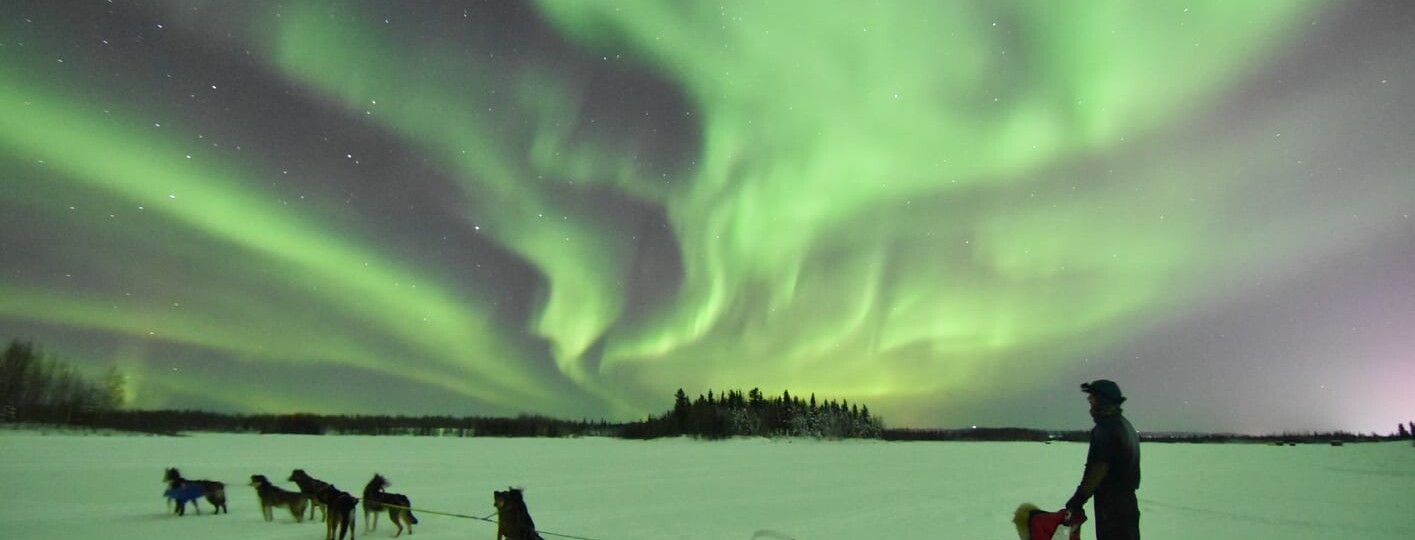
Seeing the Northern Lights in Fairbanks – Best Time and Places
Home | Travel | North America | United States | Alaska | Seeing the Northern Lights in Fairbanks – Best Time and Places
There’s an incredibly high chance you’ll see the Northern Lights in Fairbanks, Alaska if you visit at the right time. After all, Fairbanks is one of the best places to see the Northern Lights in the world .
The city has earned this reputation partly because of its location under the “Aurora Oval,” an area with lots of aurora activity. This prime location means you can even see the aurora borealis from downtown Fairbanks . Additionally, there’s a low amount of precipitation and light pollution in Fairbanks, both key qualities for great aurora viewing.
In fact, staying in Fairbanks for at least three nights during aurora season will give you an over 90% – yes, 90! – chance of seeing the Northern Lights in Alaska . Those are some pretty fantastic odds, so I’m sure you’re dying to learn more about aurora viewing in Fairbanks .
This article will cover:
- the best time to see the Northern Lights in Fairbanks
- the best places to see the Northern Lights in Fairbanks
- the best Northern Lights tours in Fairbanks
- where to stay in Fairbanks to see the Northern Lights
Ready to find out when and where to see the Northern Lights in Fairbanks ? Let’s get into it !
Best time to see the Northern Lights in Fairbanks
The best time to see the Northern Lights in Fairbanks , otherwise known as Fairbanks’ official aurora season, is from late August to late April. Unfortunately, throughout the rest of the year, there’s not enough darkness to see the aurora properly.
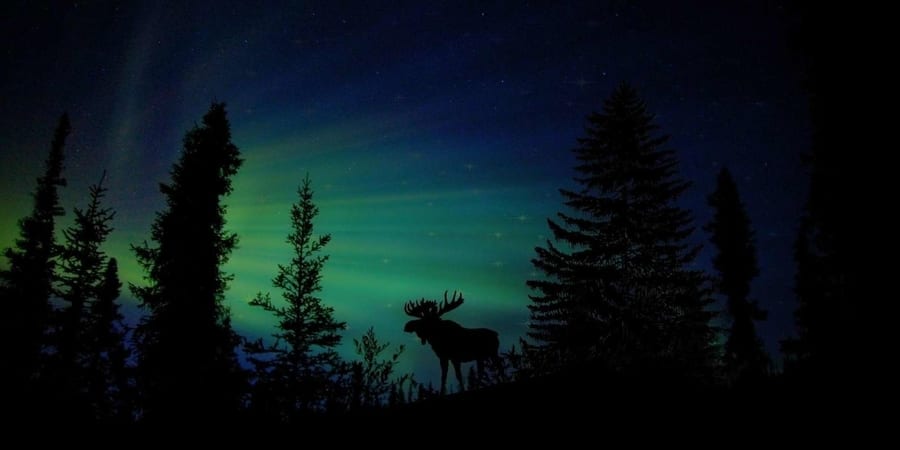
In terms of the best time of day, you’ll have the highest chance of seeing the Northern Lights in Fairbanks between 9 PM and 3 AM.
What month is best to see the aurora in Fairbanks?
In summary, these are the best months to see the aurora borealis in Fairbanks :
- August, September, and October – At this time of year, the weather is at its warmest. Additionally, there’s still enough daylight to see and do things during the day. However, the sky can often be quite cloudy, so you might not have the best visibility.
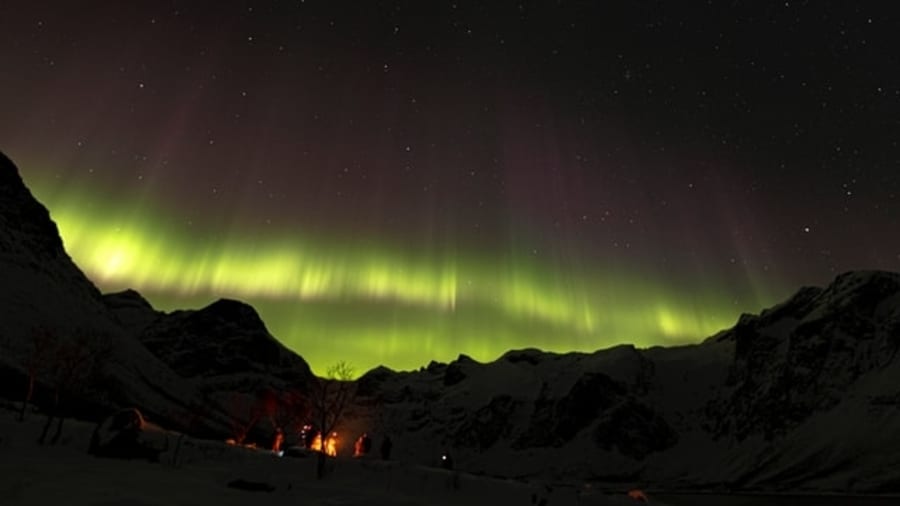
- November, December, and January – This is one of the best times to see the Northern Lights in Fairbanks . The nights are long and dark, which is perfect for aurora viewing as long as the skies are clear. On the other hand, temperatures can get quite chilly, so be prepared to bundle up.
- February, March, and April – As spring nears, the weather starts to get warmer again. The days also begin to lengthen, but there’s still a high chance of seeing an aurora display. Best of all, these months, particularly March, tend to have less cloudy weather than the rest of year .
Best places to see the Northern Lights in Fairbanks
Figuring out where to see the Northern Lights in Fairbanks doesn’t have to be difficult. There are plenty of great places around the city where you can catch a glimpse of the “Green Lady.” Ultimately, choosing your aurora viewing spot will depend on how far you’re willing to travel out of downtown Fairbanks and whether you have an all-wheel, 4-wheel, or 2-wheel drive vehicle.
- Creamer’s Field Migratory Waterfowl Refuge: This bird sanctuary, which is one of the best places to see the Northern Lights in Fairbanks , is located just 2 miles from downtown Fairbanks. Even though you’re not far from the city, there is still very little light pollution here. On top of that, the various open fields and trails mean you’ll have a practically unobstructed view of any aurora displays. Plus, the road to the refuge is well maintained, so a 2-wheel drive vehicle can get you here at pretty much any time of year.
- Chena Lake Recreation Area: Hit the trails or admire an aurora display over the lake at this 2,000-acre recreation area, located 17 miles from downtown Fairbanks. There are two separate parks within the recreation area, River Park and Lake Park. Both have very low light pollution and feature plenty of wide-open spaces, so they’re perfect aurora viewing spots in Fairbanks . Best of all, you can easily get here with a 2-wheel drive vehicle, unless the weather is very stormy.
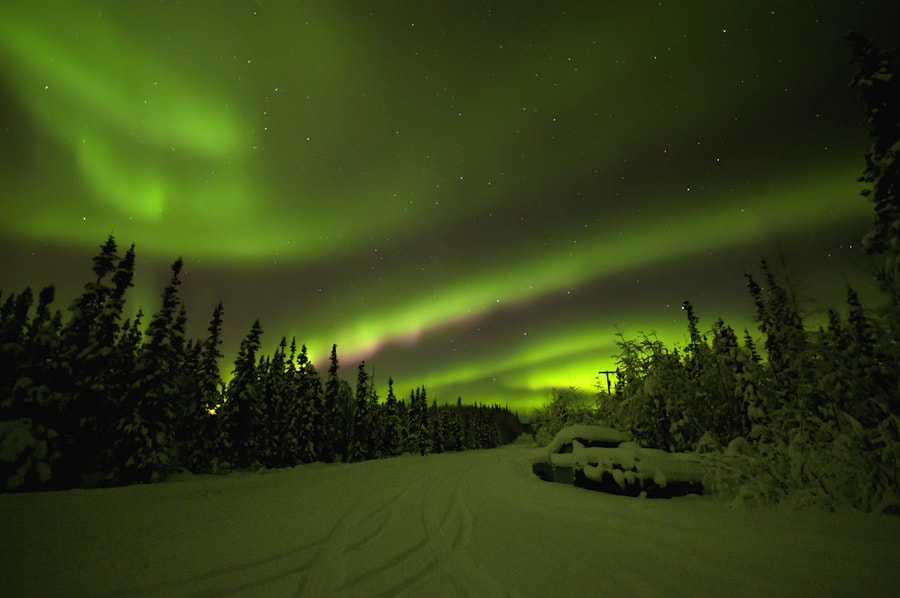
- Cleary Summit: Head to the top of Cleary Summit, located 20 miles from downtown Fairbanks, to enjoy spectacular views of the aurora over Tanana Valley and the White Mountains. You should keep in mind, however, that this is a very popular place for aurora viewing in Fairbanks . If you want a more private viewing experience, there are several locations along Steese Highway (the road to Cleary Summit) where you can pull off and get great views. Note that the summit is best accessed with an all-wheel or 4-wheel drive vehicle in the winter.
- Murphy Dome: The highest point near Fairbanks is perfect for enjoying completely unobstructed views of the sky and valley. This prime location to see the Northern Lights in Fairbanks is a bit of a drive (25 miles) from downtown Fairbanks, but the stunning views are worth it. Just keep in mind that an all-wheel or 4-wheel drive vehicle is the best way to get here during the winter.
Before you head out to your viewing spot, be sure to check the Northern Lights forecast so you know what viewing conditions will be like .
Best Northern Lights tours in Fairbanks
Of course, the easiest way to see the Northern Lights in Fairbanks is to book a Fairbanks aurora tour. There’s no shortage of aurora tour options, but, as always, not all tours are created equal.
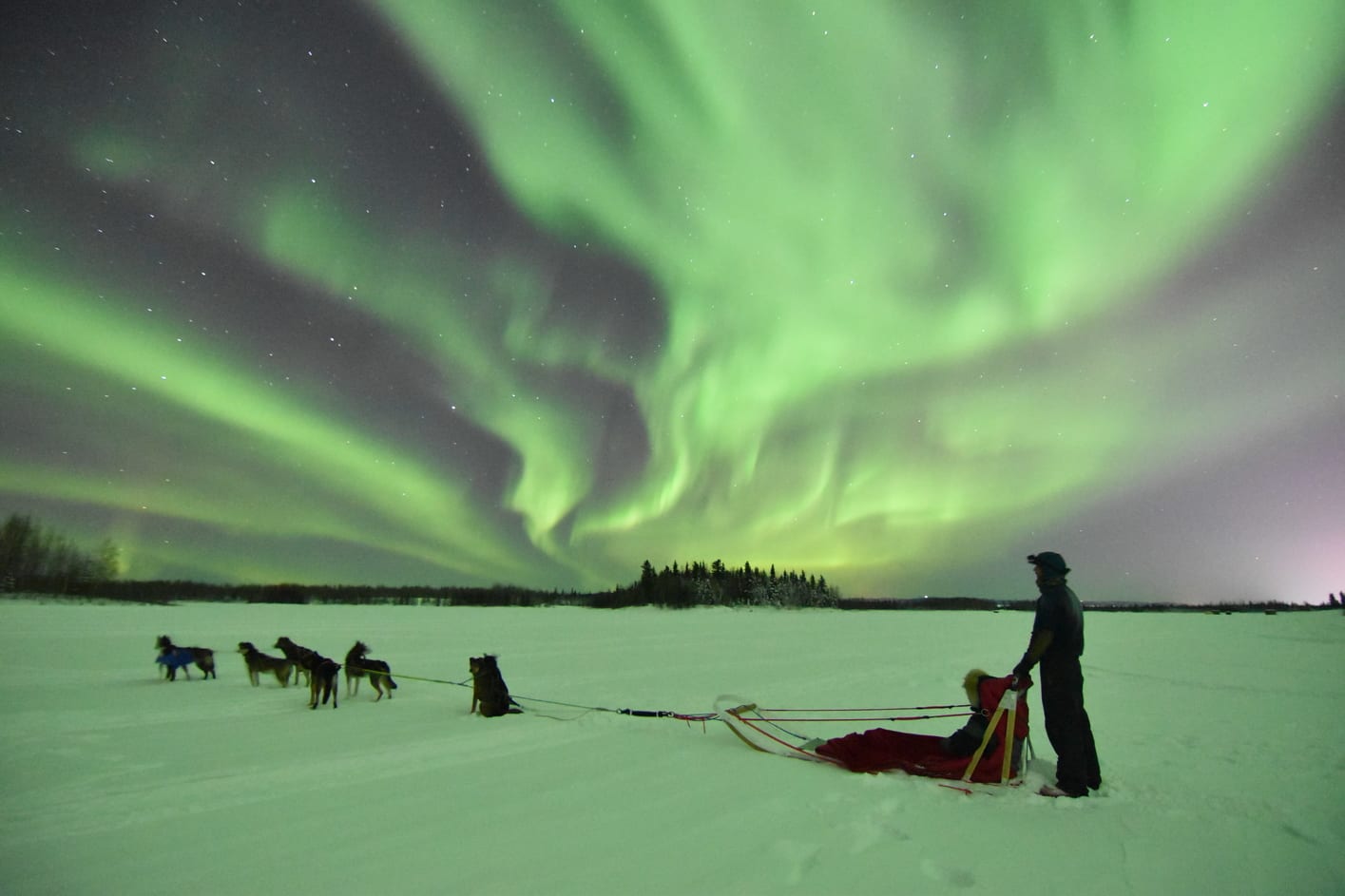
My favorite one is this Northern Lights and Arctic Circle tour , where you’ll travel along Dalton Highway, see the Trans-Alaska Pipeline, and hopefully catch the Northern Lights. Best of all, you’ll even get a certificate to commemorate your trip to the Arctic Circle.
Another fantastic option is a dog sled and Northern Lights tour . If you get lucky enough, you may just be able to see the aurora from your sled. Otherwise, you’ll have another chance to see the Northern Lights when you head to a cozy yurt after your sled ride.
Finally, I also recommend this Northern Lights and Chena Hot Springs tour . You’ll enjoy a guided tour of the Aurora Ice Museum and Chena Hot Springs, where you’ll have the chance to soak in the springs’ waters. Then, you’ll head to the Aurorium, where you’ll hopefully be able to watch an aurora display.
We also have a guide to the best Northern Lights tour in Fairbanks that I recommend checking out .
Where to stay in Fairbanks to see the Northern Lights
Yet another way to increase your chances of seeing the Northern Lights in Fairbanks is to book a hotel that specializes in aurora viewing experiences. One great Fairbanks aurora hotel is the Alaska Grizzly Lodge , which features lovely views of the Alaskan wilderness. Even better, the rooms’ private terraces are perfect for enjoying the Northern Lights without having to go very far.
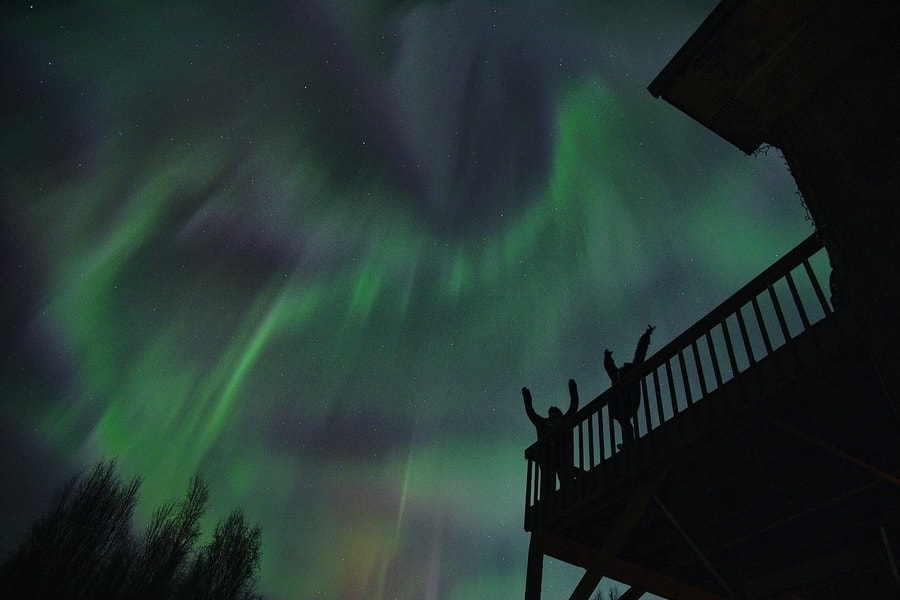
Pike’s Waterfront Lodge is another excellent option. Beyond a sauna, restaurant, and riverside deck, this hotel along the Chena River also boasts a glass-walled Aurora Conservatory, a prime spot for aurora viewing.
If you’d prefer having a vacation home all to yourself, book the Aurora and Denali View Apartment . Take in the views of the city and Denali from this home’s spacious backyard and sit out on the patio to watch the Northern Lights dance overhead.
We have another specific article with the best Northern Lights hotels in Fairbanks, Alaska , in case you need more options.
As you’ll have seen, there are plenty of reasons to see the Northern Lights in Fairbanks : the prime location, low light pollution, beautiful landscapes, and more. You can even increase your chances of seeing the aurora by staying at a Fairbanks Northern Lights hotel or booking a Fairbanks aurora tour .
Ultimately, whether you watch a Fairbanks aurora display with your tour group, from your balcony, or in the middle of the wilderness, you can rest assured that you’ll be in for an unforgettable visual treat. It’s easy to get caught up in the beauty of the moment, so don’t forget to take pictures of the aurora to have as a memento of your adventure.
Good luck chasing the Northern Lights in Fairbanks !

Ascen Aynat
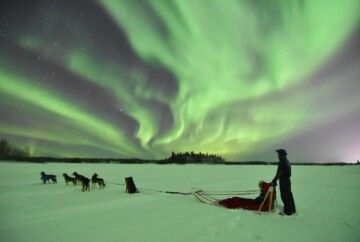
Leave a Reply Cancel reply
Your email address will not be published. Required fields are marked *
This site is protected by reCAPTCHA and the Google Privacy Policy and Terms of Service apply.

GET THE ULTIMATE free GUIDE TO PHOTOGRAPHING The Northern Lights
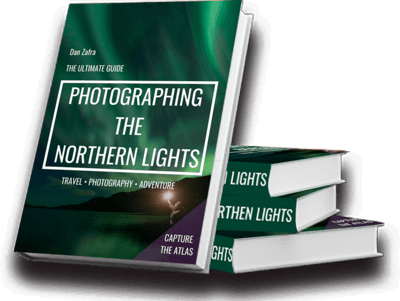
- Best time and places
- Camera gear
- Best settings
- Aurora composition
- Other tips and tricks

The Best Time to See the Northern Lights in Iceland

When Is the Best Time to See the Northern Lights in Iceland?
What is the best month to see the northern lights in iceland, when can you see the aurora borealis in iceland, can you see the northern lights in reykjavik, what are the best conditions to see the northern lights, 1. strong solar activity, 2. clear skies, 3. as little light as possible.
- Iceland’s Northern Lights Season
Can You See the Northern Lights in Iceland During Winter?
Can you see the northern lights in iceland during autumn and spring, can the northern lights be seen in the summer, what time of night is best to see the aurora borealis in iceland, what else can i do to make sure i see the northern lights in iceland, 1. avoid urban areas when northern lights hunting, 2. extend the length of your holiday, 3. travel across iceland, 4. check the weather forecast for northern lights, 5. be well-prepared and patient.
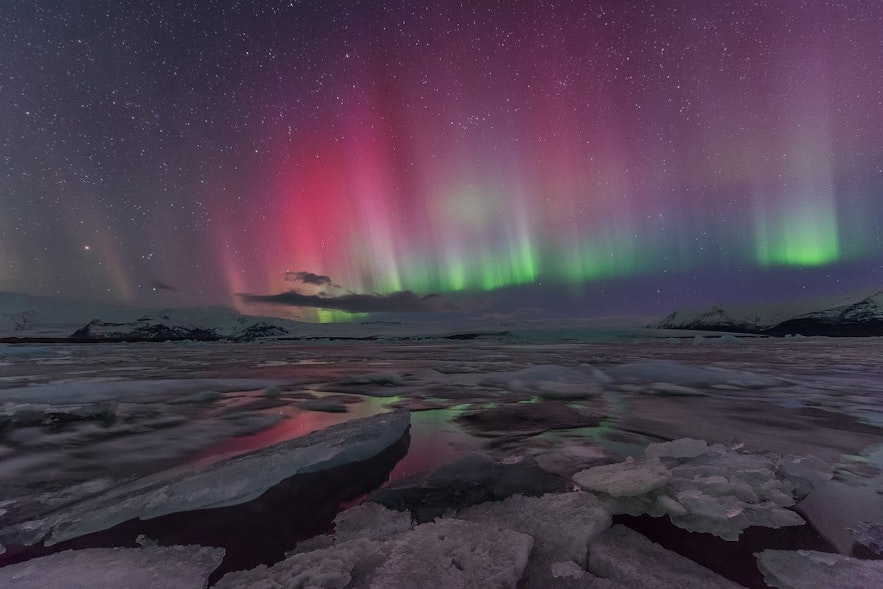
Learn the best time of year to see the northern lights in Iceland. Find out which are the best seasons and months for viewing the aurora borealis in Iceland.
The northern lights are one of nature's most magical sights, but they're also one of the most unpredictable. Maximize your chance of seeing nature’s most spectacular light show with this complete guide before embarking on a northern lights tour or renting a car on Iceland's biggest travel marketplace.
Iceland’s northern lights are one of its major attractions, but the aurora borealis are fickle. They’re only visible under certain conditions, at certain times of the year, and only with enough solar activity. Knowing when you can see the northern lights in Iceland is essential for ensuring you have the best chances of a once-in-a-lifetime viewing.
Top Northern Lights Tours & Holidays
2 day ice cave tour with south coast waterfalls & jokulsarlon glacier lagoon, 3-day northern lights tour of iceland’s golden circle & south coast with ice caving & glacier hiking, 8-day guided northern lights winter tour of the complete ring road of iceland.
- Get to know more about the aurora by reading Northern Lights in Iceland
- Find out all you need to know about Northern Lights Photography
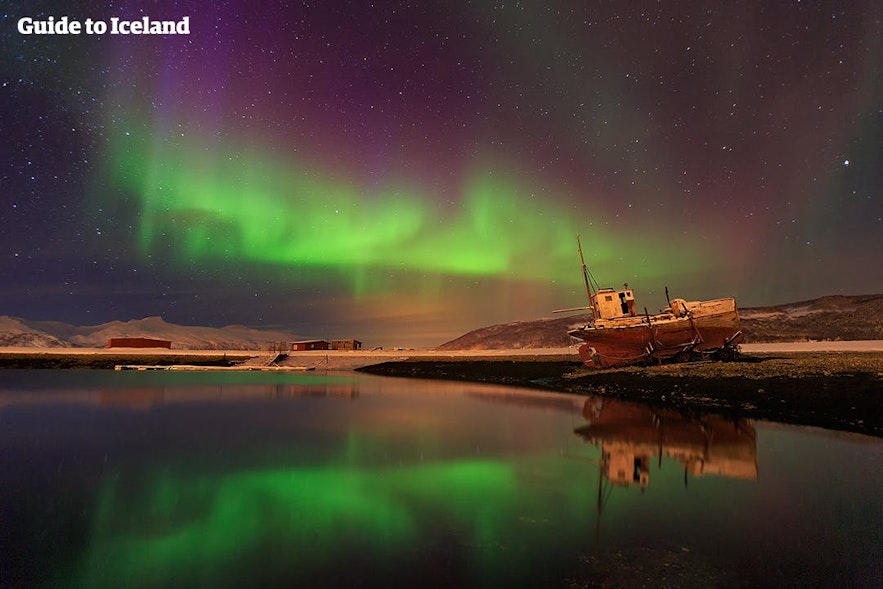
The best time to see aurora borealis in Iceland is between September and April. It’s when the nights are dark enough to see the aurora.
Iceland only gets 4-5 hours of daylight in midwinter, providing endless opportunities to hunt for aurora borealis during that time.
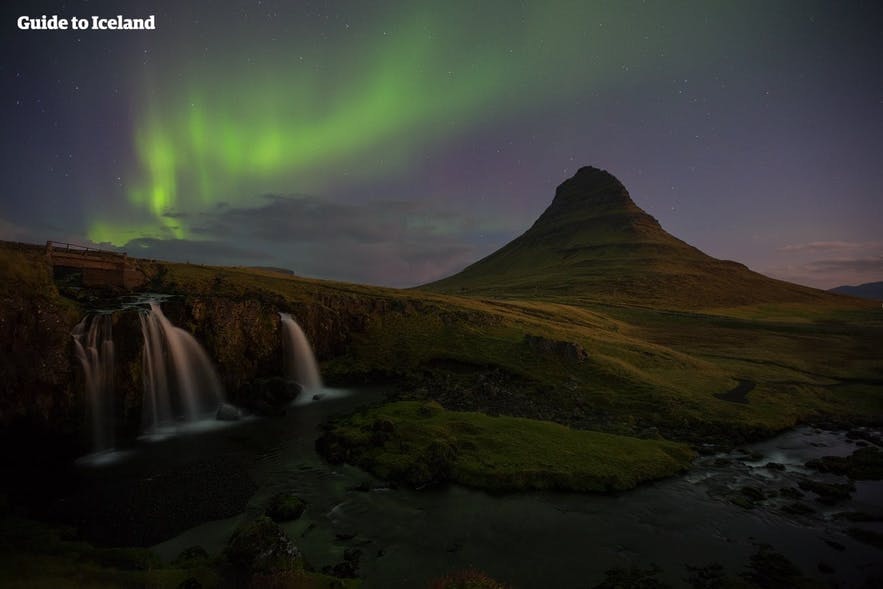
Northern lights tours run between September and April. While there’s no particularly optimum time between this range, the nights are the darkest from November to January. This means you can seek the aurora in Iceland from late afternoon until nearly noon the next day, which provides perfect conditions to photograph the northern lights .
This makes January the absolute best time to visit Iceland for the northern lights, although you have a good chance to spot the aurora borealis in Iceland until April. Then it’s a long wait until September.
- See also: Best Winter Activities in Iceland
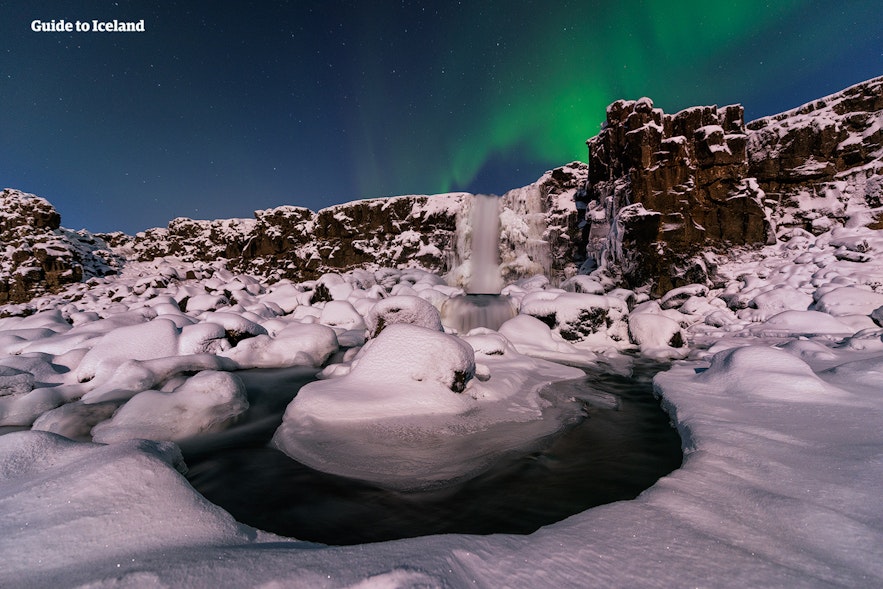
Another advantage of coming in midwinter is that you can see Iceland under a blanket of snow and make the most of Iceland’s other winter phenomena, most notably exploring the crystal blue ice caves , which are only found in a few other places worldwide.
The northern lights appear whenever there’s solar activity, but we can only spot them when it’s dark. Therefore northern lights tours only run in the winter months as the longer nights make the aurora borealis easier to spot.
In general, northern lights are visible between late August and mid-April in Iceland. But that also depends on several other factors. For the best time to go to Iceland for the northern lights, it’s best to aim for the weeks around the winter solstice.

Photo from Mesmerizing 25-Minute Northern Lights Show at Perlan Museum in Reykjavik
Though the urban light pollution usually hampers visibility, you can sometimes see the northern lights from the city center of Reykjavik. There are also areas within and around the city where the lights are more visible. Look for parks and coastal areas, like the Grotta nature reserve or the Sun Voyager sculpture, that are more isolated.
If you want some unique northern light experiences while in Reykjavik, you can combine a northern lights tour with a visit to Aurora Reykjavik , an exhibition dedicated to the aurora borealis. Alternatively, check out the award-winning Northern Lights Show at the Perlan Museum observatory!
- For more, check out the Best Places to See the Northern Lights in Reykjavik
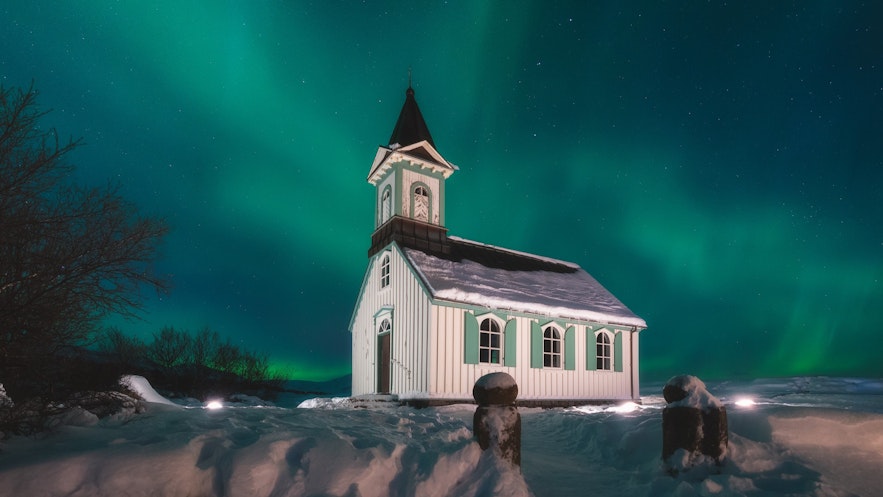
The solar wind is the reason behind the appearance of northern lights. The Kp-index forecast is the measurement unit used to indicate the level of solar activity. The optimum level is above three, and you can check this on the Aurora Forecast in Iceland.
The Icelandic Meteorological Office also has an aurora forecast on cloud covers in Iceland to help you find the best place to spot northern lights.
The darker it is, the easier it is to spot aurora borealis. You can still see the northern lights in Reykjavik and other cities, but the best results are from the remote countryside. See our tips for finding aurora borealis yourself in Iceland , including how to see the northern lights in Reykjavik.
So there is no straight answer to when you can see the northern lights in Iceland since it isn’t just dependent on the season or month but also the meteorological and solar conditions.
Iceland’s Northern Lights Season
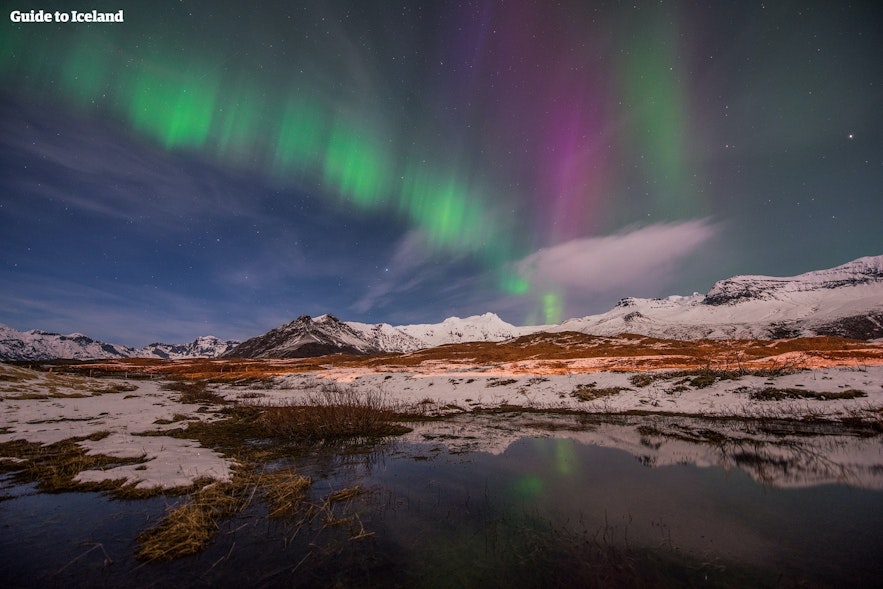
The best time of the year to see the northern lights in Iceland is undoubtedly the winter months. However, throughout these months, Iceland endures its worst weather.
Clouds can block the sky, and therefore the aurora borealis, for weeks at a time. Storms are also more common this season, occasionally leading to the cancellation of tours or the closure of main roads.
There are still plenty of winter activities in Iceland you can enjoy. You can go ice caving , snowmobiling , and glacier hiking before setting out to explore the northern lights each night.
Iceland’s weather is milder in autumn and spring (if still very unpredictable), meaning less chance of cloud cover, although note that the window of opportunity for northern lights hunting is smaller due to the increased daylight hours.

However, many summer tours extend into these months, allowing you to do more when the auroras are not visible. The Thrihnukagigur Inside the Volcano Tour continues until October and will enable you to descend into and explore a vast, unbelievably colorful magma chamber.
Whale-watching from the whale-watching capital of Europe, Husavik, begins in March and lasts until November, providing you the chance to marvel over the giants of the deep.
Keep in mind the best time for northern lights in Iceland is the winter months. However, seeing them in late autumn and early spring is still possible.
In the summer equinox weeks at the end of June, the sun never sets in Iceland. Instead, it circles the sky, touching the southern horizon but never quite sinking below it. The brightness of this ‘ Midnight Sun ’ entirely obscures the northern lights. Through the end of May, the entirety of June and July, and the beginning of August, the nights are still too bright to see the auroras.
- See also: The Midnight Sun in Iceland
Despite this, you can still see the aurora borealis faintly during the short hours of darkness at the very beginning and end of summer. Usually, they will be seen dimly against a dusky sky, often making for a uniquely beautiful display considering how vivid the colors of Iceland’s sunsets can be.
Even so, you have much less chance of seeing Iceland’s aurora borealis during these times, as they will need to be particularly intense to be visible, and there’s a much smaller window of opportunity to seek them. Suppose you want to see the aurora borealis in Iceland while still enjoying relatively mild weather and the option to partake in most summer activities. In that case, it’s recommended you come in September.
Top September Tours
- See also: Iceland in September
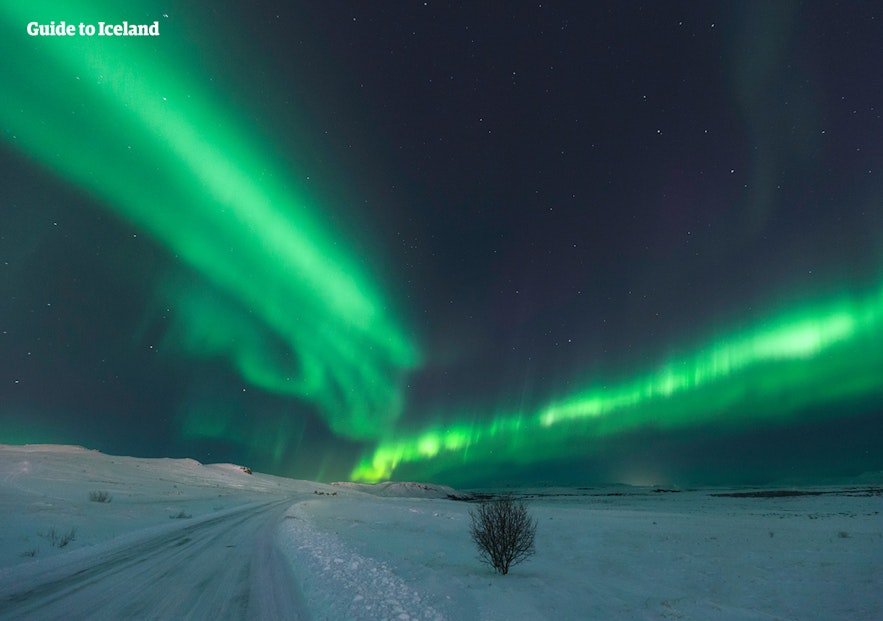
You can see the aurora borealis in Iceland whenever the sky is dark. Therefore, in December , they may be visible from three in the afternoon until nine in the morning. However, due to the Earth’s rotation, atmosphere, and magnetosphere relative to Iceland’s position on the globe, they are most likely to be seen between 10 PM and 12 AM.
This is when most northern lights tours set off. It also means that when the tours end, you’ve searched through the optimal time and back home early enough that it won’t compromise your plans the next day.
If you’re renting a car in Iceland and taking a winter self-drive tour tailored to the aurora borealis, you can search for the northern lights throughout the night. But you should remember to avoid sunrise and sunset when light pollution significantly dims them. If you are out well into the early hours hunting for the auroras, it’ll be noticeably colder, so dress accordingly.
Top Winter Self Drive Tours
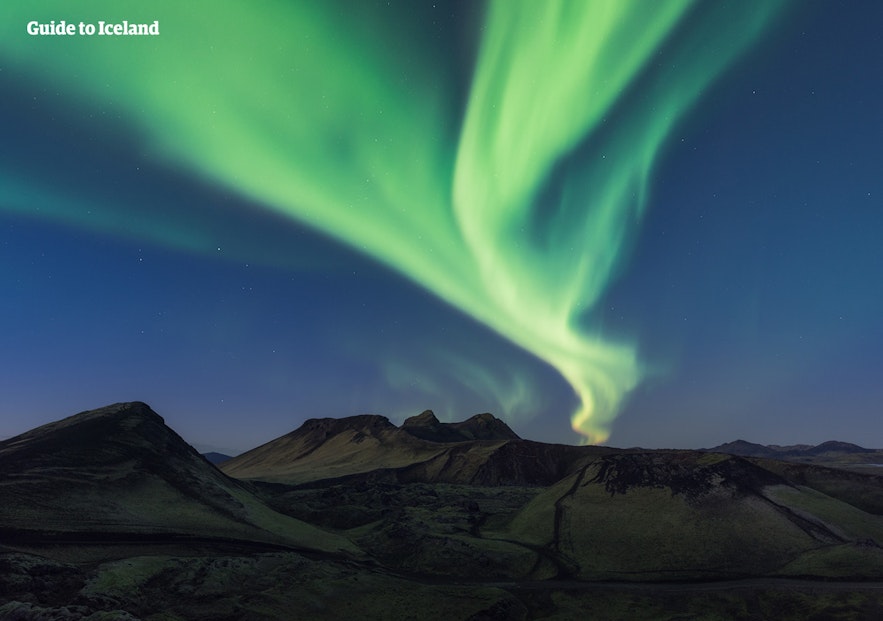
Witnessing the northern lights in Iceland always requires some luck. Some travelers dead-set on aurora hunting may encounter cloud cover or a lack of solar activity every night of their holiday. Others, traveling for one night in August , might be blessed with a fantastic show without even looking for it.
Other than waiting for a clear winter’s night, there are several ways to optimize your chances of enjoying a fantastic display of the aurora borealis in Iceland.
Just hoping you see a northern lights display without laying any groundwork is probably not the wisest option. There are several easy steps you can take to increase your chances:
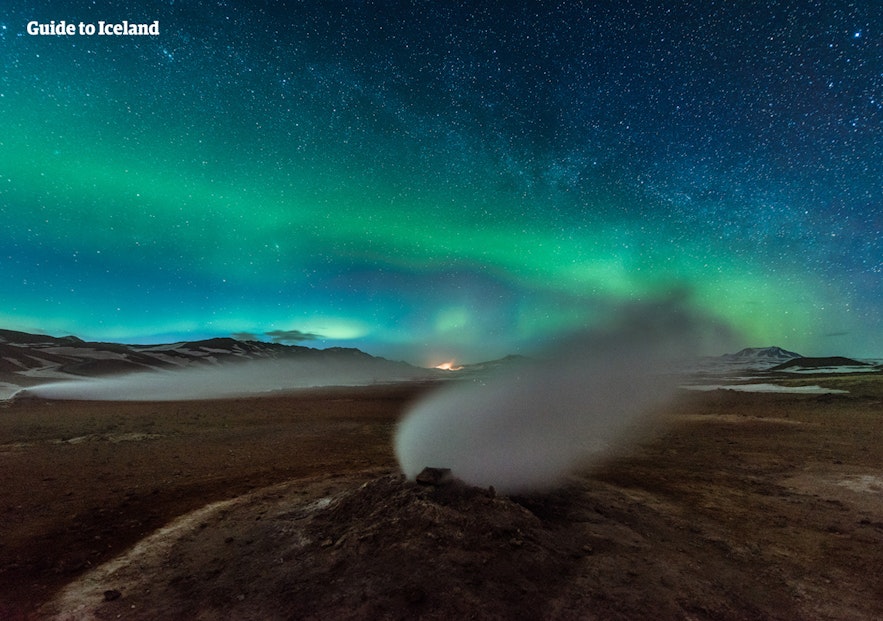
All lights have the same dimming effect on the auroras as the sun. If you’re in Reykjavik and want to see the northern lights, you must move away from the light pollution. You can take a bus to the Seltjarnarnes Nature Reserve , which is fairly dark compared to the rest of the city. However, you are more likely to achieve better results by booking a tour or driving out into the dark surrounding landscapes.
If you are on a guided package or self-drive tour, your route will take you out into the reaches of Iceland’s nature, maximizing your chances of catching a show every night.
If traveling to Iceland for just a weekend, you only have two or three nights in which to go aurora hunting. Considering the unpredictable weather and fickle nature of the aurora borealis, you’re not setting yourself up for success.
You’re statistically more likely to see the northern lights by staying in Iceland for an extended time.
A two-week-long vacation spent in different parts of the country will significantly increase your chances of a lucky night in perfect conditions.
Travelers could also consider spending much or all of their holiday in North Iceland . The nights here are longer, and the sky is usually less cloudy, providing increased opportunity. During the northern lights season, the north is also less busy than the Reykjavik area, allowing you to avoid the crowds at the most scenic viewing spots, such as the marvelous Myvatn lake or frozen waterfall Godafoss .
Iceland’s weather website has regularly updated pages revealing the predicted and current cloud cover around the country, allowing you to plan to reach the areas with the clearest skies. The aurora forecast measures from zero to nine, with three and above considered promising.
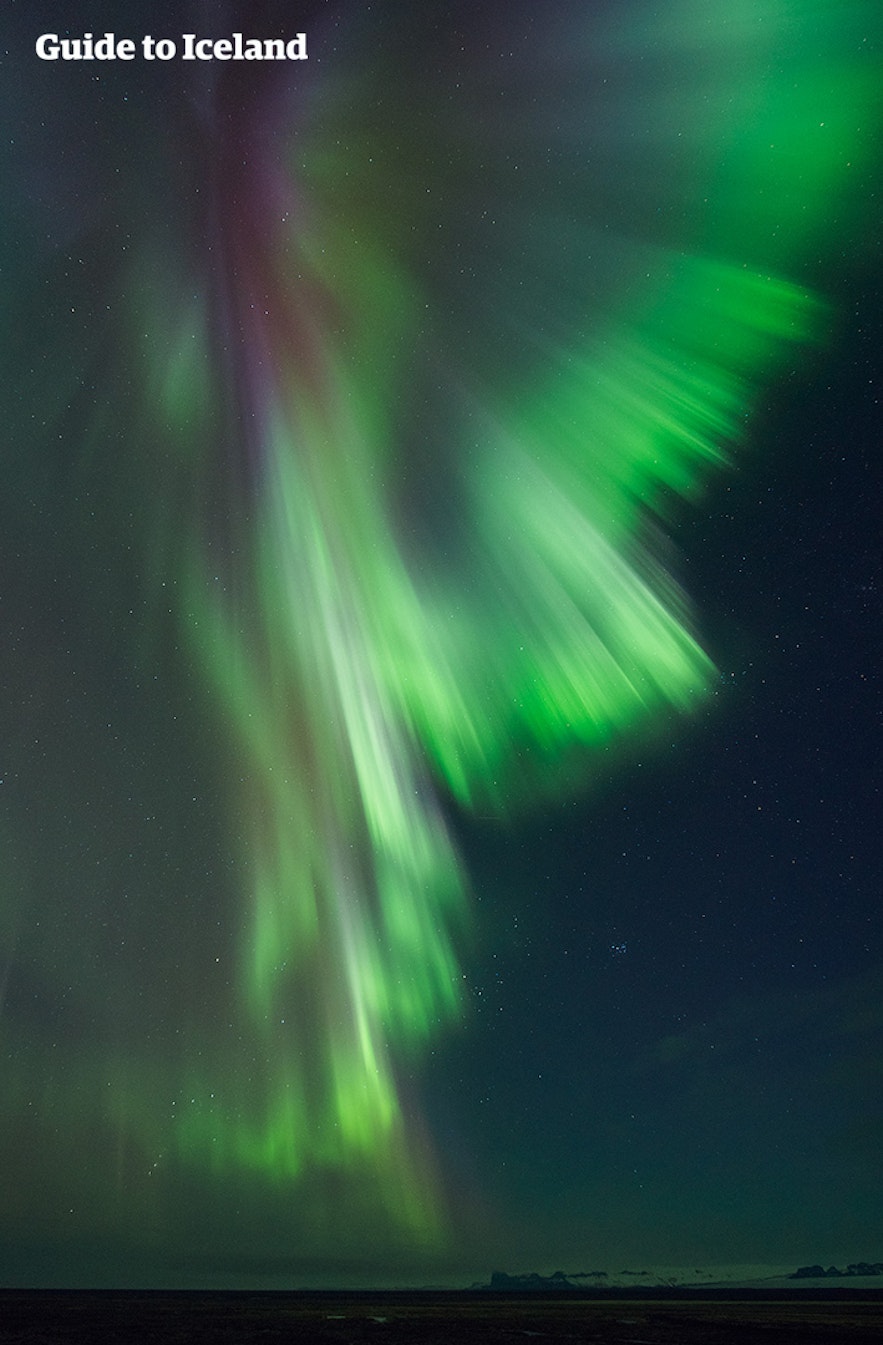
It'll take several minutes for your eyes to adjust to the darkness of Iceland's winter nights, so stay a while at each spot, even if the sky appears clear. The northern lights can also begin at any moment, so don't rush away if they aren't immediately active.
Make sure you have many layers of warm clothes - and perhaps some hot cocoa -so you can comfortably wait for the auroras as long as you need. When it comes to northern lights hunting, just a little bit of patience can lead to the most incredible rewards, which no doubt you will remember for the rest of your life.
Do you have any other questions about hunting the northern lights in Iceland? What time of year are you planning to visit? Are you considering a self-drive trip or taking a northern lights tour? Log in to Facebook to see or add to the comment section below!
Popular articles

Guide to Iceland | The Story of the Leading Travel Agency of Iceland

The Complete Guide to the Midnight Sun in Iceland

Top 20 Most Beautiful Waterfalls in Iceland

22 Photos of the Aurora in Iceland

Mountains in Iceland
Other interesting articles.
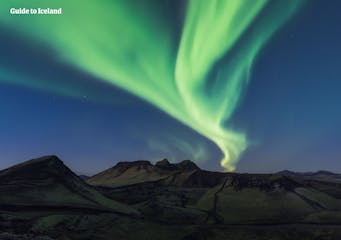
FAQ About the Northern Lights in Iceland | Science & Mythology


The Best Northern Lights Hotels in Iceland

Download Iceland’s biggest travel marketplace to your phone to manage your entire trip in one place
Scan this QR code with your phone camera and press the link that appears to add Iceland’s biggest travel marketplace into your pocket. Enter your phone number or email address to receive an SMS or email with the download link.
Top things to do in Iceland
Book your complete trip with the best companies only

Explore an Ice Cave

Visit a Live Volcano

Find the Northern Lights

Visit the Blue Lagoon

Go on a Road Trip

Do the Golden Circle

See the Glacier Lagoon

South Coast Tours
Protect Your Trip »
How to see the northern lights in iceland in 2024.
Increased solar activity means 2024 is a prime time to see the northern lights in Iceland.
Seeing the Northern Lights in Iceland

Tom Archer | Courtesy of Hidden Iceland
While Iceland isn't the only place in the world to view the northern lights, the Nordic country's prime location near the Arctic Circle means the light show can be visible for more than 100 nights per year. And 2024 in particular will provide prime viewing opportunities.
"Interestingly, the sun is reaching its solar maximum (increased activity that's conducive for northern lights) over the next few years, so 2024, 2025 and 2026 are prime years for getting a great light show," explains Ryan Connolly, co-founder of tour operator Hidden Iceland.
While you're never guaranteed to see the northern lights in Iceland, a little planning and forethought can pay off. Read on to discover the best time of year to visit, the most scenic places to go, unique tour options and more.
The best time to see the northern lights in Iceland
Northern lights forecast for iceland, tips for exploring on your own, the 5 best places to see the northern lights in iceland, iceland northern lights hotels, iceland northern lights tours.

Getty Images
According to the country's tourism authority, the best time to see the northern lights in Iceland is from September to mid-April, between 9 p.m. and 2 a.m. – and particularly around midnight.
Within that September to April period, there's some debate about the optimal time to see the lights. Connolly cautions against a visit between late March and mid-April as well as in early September "so you don't have to stay up too late to watch the sun set." He and other experts recommend the following timeframes:
- November to January: You're generally more likely to catch the northern lights during these darkest months. The sun barely rises around this time of the year, and the extremely long nights mean a longer window for the phenomenon to appear each day.
Spring and fall equinoxes: Although midwinter probably offers the best chance of catching the aurora, some people recommend viewing it around the spring or fall equinoxes – that is, around March 19 and Sept. 22 (these dates change slightly each year). The science behind this timing is complex: In short, there tends to be more geomagnetic disturbance around the equinoxes, leading to stronger auroras. But don't forget that the nights at these times are shorter than in midwinter, so your daily window for seeing the northern lights will also be shorter.
"We loved visiting in the fall for the opportunity to see the northern lights and for how few tourists there were," says U.S. News Travel digital producer Leilani Osmundson , who has visited Iceland in the fall. "Sometimes it felt like we had the whole country to ourselves!"
- New moons: Moonlight can make it harder to spot the light show if the aurora is already faint – so serious aurora chasers may want to plan their visit to coincide with a new moon.
During the rest of the year, Iceland experiences near-constant daylight, meaning there isn't enough darkness for the aurora borealis to appear. Put simply, if you visit in late spring or summer, you will not be able to see the lights, even if you go to the best viewing locations.

These are the most reliable resources for determining the likelihood of spotting the northern lights in the coming days:
- The Icelandic Meteorological Office: On the Icelandic Met Office's website , forecasts show the Kp index, which measures disturbances in Earth's magnetic field on a scale of zero to nine; the higher the number on the index, the stronger the aurora activity. The Met Office site also shows the cloud cover across Iceland, helping you determine whether you'll actually be able to see the lights.
- Iceland's Aurora Forecast: Iceland's Aurora Forecast , which is run by locals with expert knowledge of the aurora, offers a similar forecast on a slightly more user-friendly site.
Unfortunately, longer-range predictions (for example, weeks or months in advance) are less reliable. There are 27-day forecasts available, but take note that solar activity can occur rapidly and may not factor into such predictions. However, due to the sun's rotation cycle, if a strong aurora appears, it is considered more likely that the lights will appear again 27 days later, so this type of forecast may still be worth checking.

While it requires some extra planning, you can easily explore Iceland on your own. If you're considering this route for your trip, take these expert travel tips into account:
- Avoid chasing the lights: "Once you are in an area with clear skies, you just need to wait, grab a cup of hot chocolate, and hope for the best," Connolly says. "Driving around aimlessly rarely provides any benefits and isn't much fun."
- Manage your expectations: "The northern lights don't necessarily always appear to the naked eye as we see them in photos," Osmundson explains. "On our trip, they looked super green through the camera, but silvery and very faded to the naked eye."
- Consider a self-drive tour: Several tour companies offer customized itineraries for travelers who want to explore on their own.
- Opt for four-wheel drive: Rent a vehicle with four-wheel drive for safety and peace of mind on wintry roads.
- Heed road restrictions and conditions: Regardless of when you visit, don't go off the beaten track – off-roading is strictly illegal. You'll also want to check road conditions via the Icelandic government's official portal to avoid weather-related accidents.
- Consider travel insurance: An international travel insurance policy can provide car rental protections, medical care coverage and more.
Tips on Trips and Expert Picks Newsletter
Travel tips, vacation ideas and more to make your next vacation stellar.
Sign up to receive the latest updates from U.S News & World Report and our trusted partners and sponsors. By clicking submit, you are agreeing to our Terms and Conditions & Privacy Policy .

The most basic rule for catching the northern lights is to go somewhere dark – and with Iceland's sparse population, there's no shortage of places that fit the bill. From fjords and glaciers to mountains and black sand beaches , these are some of the most notable places to see the northern lights in Iceland.
Jökulsárlón
This glacial lagoon is adorned with icebergs, which break off from the huge Vatnajökull glacier to the north. It's also populated by crowds of seals, making Jökulsárlón a stunning place to commune with nature and a formidable backdrop for the shimmering aurora. You can also watch the light show from Diamond Beach, a black sand beach right where the lake drains into the Atlantic.
Reynisfjara and other black sand beaches
Reynisfjara, near the southern village of Vik, is a popular tourist spot, and it won't be hard to see why once you take in the basalt columns dotted along this black sand beach. You might be able to find yourself a quiet corner either here or on another stretch of shoreline nearby, and you'll be surrounded by beautiful scenery while you wait for the light show.
Be on alert around the water – you must pay attention to your surroundings on the beaches, as so-called "sneaker waves" can cause injury or death. Consider stopping off at the spectacular 200-foot high Seljalandsfoss waterfall on the way; it's about 40 miles from Vik, on the main road from Reykjavik.
Snæfellsnes peninsula
About 130 miles northwest of Reykjavik, the Snæfellsnes peninsula centers around a huge volcano called Snæfellsjökull. There's plenty of impressive places to view the lights here – consider staking out a spot near the unusually pointy Kirkjufell mountain or on Djúpalónssandur beach, with its black sand and craggy rock formations. You can stay overnight in a number of villages in the area.
Reykjanes peninsula
Reykjanes has plenty of naturally beautiful backdrops for catching the lights. Kleifarvatn, a large and tranquil lake ringed by small mountains, sits about 20 miles south of Reykjavik, while another option is Krýsuvík, a geothermal area with hot springs south of the lake.
Thingvellir
This volcanic national park is located on the rift between two continental plates. About a 30-mile drive east of Reykjavik, Thingvellir – written as Þingvellir in Icelandic – offers varied scenery from volcanoes to lakes to famous Iceland waterfalls . Take note: As part of the Golden Circle tour route, Thingvellir is a popular spot for aurora viewing, so you may not be alone.

Kristján Pétur Vilhelmsson | Courtesy of Hotel Rangá
If you're planning a self-guided visit, book an Airbnb or hotel that caters to aurora spotters. Below is a sampling of hotels that offer special viewing locations and wake-up calls if the lights appear after you go to bed.
Hotel Rangá
Tucked in a charming timber building near the south coast of Iceland , this hotel specializes in aurora viewing, with an observatory on its roof and an aurora wake-up service. The hotel also lends out snowsuits for those who want to spend time outside and boasts a 24/7 bar with hot drinks to seal the deal. Guests have praised Hotel Rangá's incredible service, calling it the kind of luxury place that's relaxing and not too formal.
The Retreat Hotel and Silica Hotel
The Blue Lagoon's geothermal waters would be a formidable place to spot the northern lights, but daytime visitors can't stay past late evening – before the aurora tends to appear. However, guests in the two on-site hotels don't have to stress about this timing. Offering ultra-chic minimalist rooms, access to private lagoons and otherworldly views, The Retreat Hotel and Silica Hotel at the Blue Lagoon resort offer a true luxury experience, with prices to match. Despite the price, guests rave about the beauty of this hotel's location and its stylish design.
Hótel Húsafell
Located on a former farm in the Icelandic wilderness, this hotel says it gets an average of three aurora sightings per week in the winter months. Hótel Húsafell also offers a complimentary aurora wake-up service so you don't miss the show. Its location near the Langjökull glacier means stellar views during the day too. Recent visitors enjoyed the range of activities on offer around the hotel in addition to the restaurant, noting that although the menu options are limited, the food is divine.
Panorama Glass Lodge
There's no need to go out in the cold to see the northern lights when you're staying in an all-glass cabin. Hot tubs and heated floors at the Panorama Glass Lodge make the views over the rocky tundra all the more cozy. Guests have plenty of compliments for this lodge's scenic setting, as well as the luxury and comfort of its one-of-a-kind design.
Hótel Búdir
A rustic building now plays host to this stylish yet homey hotel on the Snæfellsnes peninsula, with aurora wake-up calls; fine dining sourced from local purveyors; and stellar views that span glaciers, lava fields and the Atlantic. According to past guests, the old-timey charm and restaurant and bar are serious highlights at Hótel Búdir (also written Búðir).
Skálakot Manor Hotel
This luxury lodge is located on a horse farm in remote southern Iceland – the perfect place to spot the aurora. In addition to tours on horseback, the hotel offers cozy guest rooms, a fine dining restaurant and a spa. Recent visitors, many of whom visited to enjoy the resort's amenities for a day, note how stunning the location is.

Northern lights tours with a guided expert may increase your chances of spotting the natural phenomenon, but remember: Seeing the northern lights is never a sure bet, and as such, tour operators have various policies to account for this. Below are some of the best tour options.
Multiday tours
- Hidden Iceland: Hidden Iceland offers an immersive, private Must See 6+ Day Private Tour Winter Itinerary that combines daytime activities like discovering a blue ice cave with overnight stays in remote locations that are ideal for spotting the northern lights. Recent travelers praise Hidden Iceland, especially the tour guides.
- Arctic Adventures: Arctic Adventures offers a two-day tour focused on the aurora and the Snæfellsnes peninsula north of Reykjavik, including sights of waterfalls and a black sand beach. A six-day tour with Arctic Adventures explores the south of the country, including an ice cave and a black sand beach, as well as a northern lights boat excursion from Reykjavik. Take note, though, that this tour does not accept children younger than 8, while the age minimum for the two-day tour is 6 years old. The company has received generally good feedback for its organization – negative reviews tend to come from customers who didn't get to spot the aurora.
- GJ Travel: Another reliable bet is GJ Travel, which has been showing visitors around Iceland for more than 90 years. This tour operator has garnered high praise for its "jam-packed" itineraries and extremely experienced guides. GJ Travel offers multiple northern lights tours that also stop off at key sights around Iceland. Choose a five-day tour or an eight-day trip , and know that these excursions may carry up to 40 people.
Northern lights tours from Reykjavik
- Iceland Everywhere
- Reykjavik Outventure
- Special Tours
- Elding Whale Watching
For more options, check out our list of the best Iceland tours .
Frequently Asked Questions
Yes, the northern lights can be visible from Reykjavík . "It's a myth that it's impossible to see them in the city," Connolly says. "If you find yourself stuck in Reykjavík each night, don't be disheartened – there are still plenty of places with wide-open views of the ocean and away from direct light, such as along the harbour downtown." Other local viewing spots include:
- Öskjuhlíð: This hill on the south side of Reykjavík offers decent views of the northern lights from the top. While you're up there, you can visit the spectacular glass-domed Perlan, a museum and restaurant offering an immersive aurora documentary in its unique planetarium, as well as spectacular views over Reykjavik. Although it's possible to see the lights from Perlan, the museum typically closes midevening, before the best viewing hours for the aurora.
- Seltjarnarnes peninsula: Located on the western edge of the city, this area's top viewing spot is the Grótta lighthouse, which provides scenic vistas of the night sky just far enough from the city lights.
- Mount Esja: If you have a car but want to stay close to the city, consider driving less than 20 miles out of toward snow-capped Mount Esja, which provides a splendid backdrop for the light show (but note that hiking on the mountain is not recommended during aurora season due to icy conditions).
Yes, though it's less likely as the Blue Lagoon typically closes in the late evening during the winter and early spring, which is often too early to see the northern lights.
Iceland's weather can be unpredictable. Because there's no easy way to plan around the changing forecasts, it's best to book a longer visit to the country. A two-day jaunt could easily be ruined by one patch of cloudy weather; if you stay on the island for a week, however, your chances of catching clear skies are much better.
You might also be interested in:
- The Best Packable Jackets
- How to See the Northern Lights in Alaska
- The World's Best Places to See the Northern Lights
- The Best Travel Insurance for Europe
Most Beautiful Landscapes in the World

Tags: Travel , Europe Vacations , Travel Tips
World's Best Places To Visit
- # 1 South Island, New Zealand
- # 4 Bora Bora
If you make a purchase from our site, we may earn a commission. This does not affect the quality or independence of our editorial content.
You May Also Like
Flight canceled or delayed what to do.
Amanda Norcross April 26, 2024

The Best Beach Hats
Megan Johnson and Sharael Kolberg April 26, 2024

The Best Florence Tours
John Rodwan April 25, 2024

The 9 Best Louisiana Swamp Tours of 2024
John Rodwan April 24, 2024

How Much Does a Cruise Cost?
Gwen Pratesi April 24, 2024

The Best Whale Watching in Cape Cod
Lyn Mettler April 24, 2024

Best Whale Watching Tours in Maine
Marisa Méndez April 23, 2024

The Best Wineries in Napa Valley
April 23, 2024

The Best East Coast Beaches
April 19, 2024

The Best Carry-on Luggage
Erin Evans , Rachael Hood , Catriona Kendall , Amanda Norcross and Leilani Osmundson April 17, 2024


10 Best Places To See The Northern Lights Around The World
- The Aurora Borealis is a natural phenomenon that occurs when the sun's charged particles collide with gas particles, creating colorful lights in the sky.
- The best places to view the Northern Lights are typically in Alaska, certain parts of Canada, Norway, Finland, Greenland, Iceland, Scotland, Pennsylvania, and Sweden.
- Travelers can expect to see the Northern Lights during specific periods of the year, usually in September's last two weeks and the second to third week of March. Availability and prices for accommodations and tours may vary.
Aurora Borealis, the Northern Lights, showcases beautiful hues of green, pink, blue, and violet lights dancing in the night sky. Fortunate tourists can witness this phenomenon during specific periods of the year in the Northern Hemisphere.
Aurora Borealis is a natural phenomenon that occurs as a result of a collision of the sun’s electrically charged particles and gas particles like nitrogen and oxygen. This creates a mixture of colors in the clear sky, best viewed in areas with little to no pollution and no precipitation. This is why the best bets for viewing are typically in Alaska and certain parts of Canada, which have longer nights. Because the northern lights happen due to solar activity, travelers can expect the phenomenon to appear usually during September’s last two weeks and the second to third week of March .
Witnessing this majesty is undoubtedly on anyone’s bucket list, and these are the 10 best places to see the northern lights around the world.
Tromso, Norway
Tromsø is right in the center of the Norwegian Arctic aurora zone, making it one of the best places to witness the Aurora Borealis annually. This city in Norway is only a 3.5-hour direct flight from London, with the best northern light views from September to April.
Travelers can stay in Thon Hotel Tromsø, a mid-range hotel that offers viewing spots on the roof deck. This Norwegian city also features vibrant vibes, with famous bars and pubs on every street.
- Thon Hotel Tromso rate: $111.29 per night for 2
- Best activity, besides viewing the northern lights: Husky Tours
Related: 20 Of The Best Places To Get A Better View Of The Aurora Borealis
Fairbanks, Alaska
Tourists traveling to Alaska can head to Fairbanks , located just underneath the Auroral oval, where the light activity is concentrated. The best time to view the Aurora Borealis in Fairbanks is between August 21 and April 21 .
Travelers can check out Borealis Basecamp for a private igloo, one of the Fairbanks’ top glamping resorts. Others can check out Chena Hot Springs Resort , which includes round-trip transportation to join an Aurora viewing tour or head to Aurora Ice Museum .
- Chena Hot Springs Resort Shuttle Fee: $180 per person round-trip
- 3 days / 2 nights in Borealis Basecamp: $980 per person
Lapland, Finland
Lapland is another location within the Arctic Circle, in Finland’s northernmost part. Travelers can expect to see the Northern Lights from late August to April, about 200 times annually. One of the best bucket list experiences is watching the light show from Santa’s Hotel Aurora .
A few resorts in Lapland also host Aurora hunting expeditions, such as Kakslauttanen Artic Resort , with glass igloos, wooden rooms, and traditional log houses. The expeditions typically involve travelers watching the lights while riding a sleigh or skiing.
- Kakslauttanen Artic Resort Glass Igloos: Starts at $483.74 per night
- Santa’s Hotel Aurora: Starts at $121 per night
Other accommodations in Lapland also offer lakeside domes, cabins, and seaside glass villas with glass roofs and large windows for the best Aurora Borealis views.
Voyageurs National Park, Minnesota
Voyageurs National Park is a 218,000-acre tourist destination on the Ontario and Minnesota International Border. It’s the sole national park in Minnesota, designated by the International Dark-Sky Association in 2020 as a dark sky park. This famous national park has minimal pollution, so seeing the Aurora Borealis is possible.
Voyageurs National Park provides campsites where tourists can spend the night to catch the Northern Lights. Cantilever Hotel is also a common lodging option for travelers who prefer to sleep on a bed while watching the Aurora Borealis.
- November to April: The best time to view the Aurora Borealis
- Cantilever Hotel rate: Starts at $175 per room per night
Related: These Are The 10 Best Northern Lights Hotels In The US
Yellowknife, Canada
Yellowknife, more popular for being North America’s Aurora Capital , sits at the center of the Aurora Oval, with the best views from mid-November to early April. Tourists can also expect to catch the northern lights for up to 240 nights annually .
Besides the Aurora Borealis, travelers can also engage in winter sports in Yellowknife, such as cross-country skiing and ice fishing. Aurora Village tours are also available for viewing the northern lights, with free pick-up from hotels around the area.
- Aurora Village tour: Starts at $99.82 per person
- Aurora Village Hotel Package: Rates differ during fall and winter
Ilulissat, Greenland
Ilulissat, Greenland , has minimal light pollution, offering near-perfect Northern Lights visibility. The aurora season in this location occurs from September to early April. Travelers can combine Aurora viewing with daytime activities like Arctic caving and dog sledding.
Kangerlussuaq is another popular destination in Greenland to view the Aurora Borealis, with a chance to catch the natural phenomenon close to 300 times a year . Travelers can book northern lights tours from Albatros Arctic Circle, which also involves camping.
- Northern Lights Tour (Ilulissat) : 2-hour duration, between November to April
- Hunt for Northern Lights (Kangerlussuaq): 2 hours, February to April or September to November
Reykjavik, Iceland
From October to March, tourists traveling to Reykjavik, Iceland, can witness the Aurora Borealis in various attractions and natural parks. The best location for aurora viewing is at Öskjuhlið, with clear skies and no pollution. Reykjavik features hilly and wooded areas 200 feet above sea level for the spectacular light show.
Tourists can book packages and tours at Buubble Tours , featuring scheduled and private tours to make the most of the Iceland escapade.
- Golden Circle Iceland Tour: Around $816.08 per person
- 4-day Private tour: Starts at $8,980.90 for 2 travelers
RELATED: 10 Things To Do In Iceland In Autumn (Including Watching The Northern Lights)
Orkney, Scotland
Orkney is 10 miles from the remote northern coast of Scotland and is one of the best locations to view the Aurora Borealis in the UK. Travelers can witness the northern lights in fall and winter during cold and dark evenings.
The recommended locations in Orkney are Dingieshowe Beach and the Birsay coast. Orkney also features beautiful coastal landscapes and abundant sheep wildlife. There’s also the Heart of Neolithic Orkney, one of the UNESCO World Heritage Sites.
- The Kirkwall Hotel: Starts at $86.50 per room per night
- Other popular places in Orkney: Wideford Hill and Inganess Bay
Travelers can join groups on Facebook for timely updates on the Aurora Borealis, like the Orkney Aurora Group on Facebook.
Cherry Springs State Park, Pennsylvania
Cherry Springs State Park in Pennsylvania is another International Dark Sky Park , isolated from large cities like Pittsburgh and Philadelphia. Travelers can get the best Aurora Borealis photos here .
Visitors can become updated with the Aurora Borealis schedule by listening to the forecast services of The University of Alaska Fairbanks .
- September: Best month to view the Aurora Borealis
- Other phenomena that can be viewed in the park: Omega Nebula and the Milky Way
Jukkasjärvi, Sweden
Jukkasjärvi is in Northern Sweden, a small Swedish Torne River village 125 miles over the Arctic Circle . A chilly adventure calls for an overnight stay in Icehotel, where guests can enjoy ice rooms, suites, and chalets while catching the Aurora Borealis.
Travelers can also book nightly photography tours or go on excursions to Abisko’s Aurora Sky Station , located nearly 3,000 feet above sea level . The station offers the best Aurora Borealis views from November to March .
- Northern Lights Dinner at the Aurora Sky Station: $203.43 per person
- Aurora Borealis photography tour: $154.52 per adult
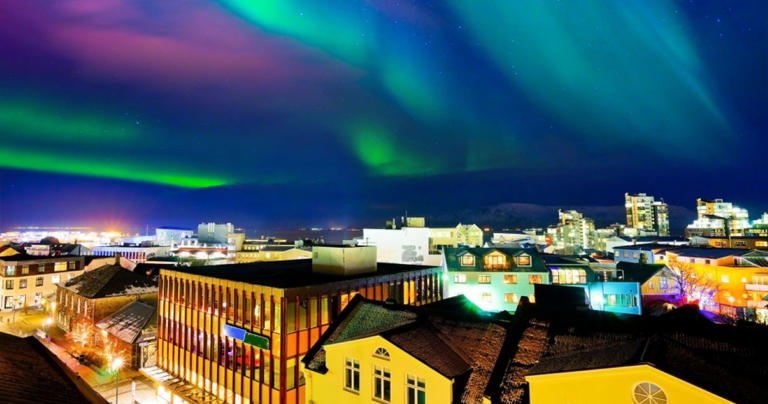
Best times to see the aurora borealis across Canada
The dazzling, colourful dance of the Northern Lights is a breathtaking spectacle that should be on every traveller's bucket list — but timing is everything when it comes to catching the auroral display in all its glory.
While the lights have been seen throughout the year, your chances of viewing them are greater during certain seasons ( 1 ). Across Canada's northern skies, the best chances to see the Northern Lights are between late August through April. Autumn and early winter mean long, dark nights. The cold weather also brings a higher chance of clear skies in northern latitudes — ideal for aurora viewing.
Our local experts have put together this guide to the best times and places across Canada to see the Northern Lights shimmer across the country’s night skies.
Table of contents
Popular northern lights tours in canada, winter: december to february, spring: march to may, summer: june to august, fall: september to november, factors affecting the visibility of northern lights.
- Best time to see aurora borealis across Canada by location
Fall Colours and Northern Lights in Yellowknife
This four-night itinerary combines two iconic experiences: the beauty of Canada’s fall colours and the natural wonder of the Northern Lights. You’ll travel to Yellowknife, the capital of the Northwest Territories. Along with taking in nature’s best, you’ll enjoy seasonal activities, such as hiking, fishing and wildlife tours.
Trip length (number of nights): 4 Nights in Yellowknife: 4 Aurora viewing evenings: 3
Yukon Northern Lights Resort and Spa in Winter
This itinerary takes you from Vancouver to Whitehorse, the capital of the Yukon, before a short transfer to the resort. Far from city lights, this remote resort offers only northern-facing cabins for prime viewing in comfort. Enjoy the sauna, try dogsledding, and explore the cultural highlights of Whitehorse.
Trip length (number of nights): 5 Nights in Whitehorse: 4 Aurora viewing evenings: 4

Keep reading or chat with one of our local travel experts. We’re passionate about Canada and can help you at any stage of your vacation planning.
Winter is an enchanting time to witness the Northern Lights in Canada, thanks to its long, dark nights and frequent clear skies. For both locals and visitors , this season offers the chance to experience other unique activities like ice-fishing, snowshoeing, or simply enjoying a hot cocoa by the fire in a cozy winter lodge.
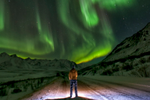
Even as the temperatures start to rise in the spring, the aurora borealis doesn't take a break. Northern regions of Canada continue to put on a show, and it's a great time for wildlife enthusiasts to mix aurora viewing with wildlife tours and even birdwatching as migratory birds return for the season.
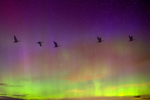
While summer means more daylight and less aurora viewing time, it's not impossible to see the lights i n the some Northern areas of Canada — where there is nightfall . Do note that some areas do not get much dark during the summer at all. Both the Yukon and the Northwest Territories experience the Midnight Sun during the summer, and in the northernmost regions the sun doesn’t set for months. Visitors can enjoy activities like fishing, hiking, or exploring local markets during the long, sunny days.

Fall is the second-best season — after winter — for viewing the Northern Lights. As the days shorten and the nights darken, the aurora becomes visible again . This season offers visitors a scenic landscape painted with the golds and reds of the leaves changing colour, a sight followed up with the vibrant nighttime spectacle of the aurora b orealis.

- Solar Activity : The Northern Lights are caused by solar particles colliding with atmospheric gases. Therefore, higher solar activity typically leads to more vibrant and frequent displays. Keep an eye on the solar activity forecast to increase your chances of witnessing this spectacular show. The period of peak solar activity during the sun's solar cycle is known as the solar maximum . Scientists have predicted that the next solar maximum will occur in 2024.
- Weather Conditions : Clear, dark skies are crucial for viewing the Northern Lights. Overcast conditions can obscure the view, making a clear weather forecast your best friend for aurora hunting. Winter seasons are usually the best because of longer nights and clearer skies.
- Light Pollution: Areas with less light pollution, such as rural locations away from city lights, offer the best viewing conditions ( 2 ). Bright city lights can outshine the aurora, so it's recommended to seek out dark sky preserves or remote areas for the best experience.
Why book your trip with Fresh Tracks Canada?
Unforgettable Canadian vacations made just for you
Enjoy local expertise and guidance with a fully planned itinerary. Personalize your trip by adding extra time in Canada at the start or end of your Northern Lights tour.
We take care of all the details
Relax and focus on making memories. Let us make all of the bookings for you, including your guided Northern Lights tour, hotels, excursions and activities, and transfers.
Support when you need it
We’re here to make sure you get the inside scoop before you even leave home. And you can relax on your vacation because you know that we’re a phone call away if you have any questions while you’re in Canada.
B est time to see aurora borealis across Canada by location
Canada is the world’s second largest country and offers many places to take in the lights. Whether you come to see this simmering spectacle in Yellowknife in the Northwest Territories or Churchill in Manitoba, every Northern Lights destination in Canada offers an unforgettable experience.
1. Yellowknife, Northwest Territories
As the capital of Canada's Northwest Territories, Yellowknife is regarded as one of the country's top aurora cities with optimal northern location and weather conditions. The lights appear here on average three nights per week from late August through April, with peak viewing between 10p.m. and 2a.m. Though cold, winter temperatures help guarantee clear dark skies ideal for spotting the aurora borealis.
The prime aurora viewing season in Yellowknife is between August and October.
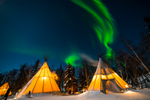
2. Whitehorse, Yukon
Though not as far north, Whitehorse still offers excellent northern lights viewing from late summer through early spring. Auroral displays begin as early as 9p.m. during winter months when nights are longest. Wait for cold, clear nights and escape the city's light pollution for prime viewing opportunities.
The best time to see the Northern Lights in Whitehorse is between September and early April.
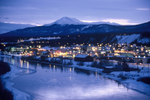
3. Churchill, Manitoba
Beloved polar bear capital by day, Churchill transforms into one of the world's best northern lights viewing destinations after dark. Well over 200 nights annually feature the mystical glow of the aurora from late summer through spring. Churchill’s location directly under the auroral oval means it often experiences active, colourful displays.
The prime aurora viewing season for Churchill is between late August and April, with January to March being the best months.

4. Inuvik, Northwest Territories
As Canada's northermost town, Inuvik experiences northern lights around 240 nights per year , from August through early May. Located above the Arctic Circle, the town enjoys direct views of colo u rful auroral arcs and streams. Prime viewing lasts several hours after dark.

5. Iqaluit, Nunavut
Aurora displays frequent the skies above Iqaluit from late August through April, peaking in brillance and activity between 10p . m . and 1a . m. The N orthern L ights are visible more than 200 nights a year , glowing brightly above the rocky tundra.
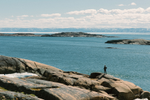
6. Tuktoyaktuk, Northwest Territories
This remote hamlet on the Arctic Ocean is considered Canada's northern lights capital, with dazzling displays happening more than 300 nights annually. The best time is from late September to early April. The flat, treeless landscape offers uninterrupted views of the dancing lights.

7. Watson Lake, Yukon
Thanks to its remote northern location, Watson Lake enjoys great Northern Lights viewing from September through early April. Though cold, clear winter nights offer ideal conditions for seeing the dancing auroral displays from this atmospheric town.
8. Nahanni National Park Reserve, Northwest Territories
Within the Mackenzie Mountains, Nahanni sees stunning Northern Lights on around 200 nights per year between late August and April. Though remote, its pristine skies offer ideal viewing of the mystical glowing ribbons gracing the sky.
9. Jasper National Park, Alberta
In the Canadian Rockies, Jasper National Park witnesses amazing Northern Light displays from September through March during years with high solar activity . Though less frequent than up north, the lights glow brightly above the park's majestic mountain peaks.
10. Prince Albert National Park, Saskatchewan
Though not as reliable as other destinations, this remote park still enjoys occassional Northern Light displays from September through April during peak solar activity, thanks to its relatively dark skies.
11. Kejimkujik National Park, Nova Scotia
On the country’s east coast, the Northern Lights are visible in this dark sky preserve on roughly 100 nights annually during fall and winter. Though less common here, auroral displays stand out vividly above the park's tranquil forests and lakes.
The best time to see the Northern Lights in Canada is between early autumn and late winter, depending on the region of the country. The long nights and reduced precipitation usually make for clear skies in the Canada’s northern regions, which are under the aurora oval and well suited for aurora viewing.
At NorthernLightsCanada.com , our local travel experts craft unforgettable Canadian vacations. We take care of all the arrangements for your trip, so you can relax and focus on making travel memories. Our Northern Lights trips include guided aurora viewing tours, and unique local activities, such as dog sledding, wildlife viewing, hot springs, and spas.
Explore Northern Lights by region

Discuss your Northern Lights tour with a Canadian travel expert

Or call us toll free
Sign up for travel inspiration
Our newsletter is full of travel tips and local insights for your Northern Lights tour in Canada.
- Villas & Lodges
- Apartments & houses
- Camping and Glamping
- New South Wales
- South Australia
- Western Australia
- Northern Territory
- Norfolk Island
- New Zealand
- Switzerland
- Middle East
- Southeast Asia
- Antarctica & Arctic
- Coach, Group & Escorted
- Special Interest
- City Tours & Sightseeing
- Scenic Flights & Heli Tours
- All-Inclusive Packages
- Restaurants
- Wine & Dine
- Street Food
- Art & Culture
- Shopping & Markets
- Rail Journeys
- Ski & snowboard
- Walks & Treks
- Dive & Water Sports
- Expeditions
- Parks & Reserves
- Theme & Amusement Parks
- Spa & Wellness
- Global Village
- Money & Rewards
- What’s On
- Tried & Tested
- Interviews & Profiles
- Deals & Itineraries
Subscribe to the magazine

- Vacations & Travel on Facebook
- Vacations & Travel on LinkedIn
- Vacations & Travel on Instagram
- Vacations & Travel on YouTube
V&T Newsletter
Love inspiring travel stories and exciting competitions? Get the latest news delivered to your inbox.

18 of the best places to see the Southern Lights
- facebook-f-brands (1)
- twitter-brands (1)
- linkedin-in-brands
- envelope-solid
From Australia to New Zealand and Antarctica, these are the best places to view the spectacular celestial display known as the Southern Lights: the aurora australis.
The Southern Hemisphere’s greatest light show is often overshadowed by its northern counterpart, but the aurora australis is just as impressive as the borealis. The celestial dance of shimmering lights in shades of red, green, purple and blue can only be spotted from some of the region’s most remote locations: the island state of Tasmania off Australia’s south coast, the southernmost points of New Zealand ’s South Island, and Antarctica . The Southern Lights are a once-in-a-lifetime experience for most casual astronomers, while dedicated aurora-chasers spend many a winter’s night chasing the illusive phenomenon. Regardless of which camp you fall into, we’ve pulled together the ultimate guide to the best places to see the Southern Lights in Australia and New Zealand, plus advice on when to search for them.
Which countries can see the Southern Lights?
The aurora australis can be seen from certain parts of New Zealand, Australia, Antarctica and South Georgia Island of the British Overseas Territory.
What is the difference between aurora borealis and aurora australis?
Aurora australis and aurora borealis are the results of the same natural phenomena. However, aurora borealis, known as the Northern Lights, is the most famous of the pair due to the expansive area from which it can be viewed and how visible the lights are at these locations. Aurora australis is only viewable from more remote locations and is typically a faint and fleeting blink-and-you’ll-miss-it moment.

What are the Southern Lights, and what causes aurora australis?
The aurora australis, also known as the Southern Lights, is a natural phenomenon that occurs when electrically charged particles from outer space collide with the Earth’s atmosphere and encounter atoms of oxygen or molecules of nitrogen. The green and red light typical of the Southern Lights results from the particles colliding with oxygen at different altitudes, while the purple light comes from the particles colliding with nitrogen. Both auroras in the north and south are polar, as they occur near Earth’s magnetic poles and are drawn to Earth by these magnetic fields. The Southern Lights appear in shades of green, red and purple and typically shimmer across the sky when visible.
When is the best time to see aurora australis?
Aurora-chasers are most likely to witness the Southern Lights during the winter months when the nights are long, dark and free from cloud cover, and when the moon is in its darkest phase. Aurora australis is difficult to predict, and a viewable occurrence is often only confirmed up to three days in advance. Visitors to Australia can download apps such as My Aurora Forecast and SpaceWeatherLive to stay on top of the conditions; subscribe to aurora notifications from Australia’s Bureau of Meteorology Space Weather Services division; or join the Aurora Australis Tasmania Alert NOW and Aurora Australis Tasmania Facebook groups.
Where are the best places to see the Southern Lights?
The island state of Tasmania is the best place from which to view aurora australis in Australia. Those in New Zealand should head towards the South Island. Antarctica is the quintessential viewing position for the Southern Lights, while the phenomenon can sometimes be viewed on cruises to South Georgia Island between March and September.

Where to see the Southern Lights in Australia
Bruny island .
Accessed via a 30-minute drive and one ferry ride from Hobart in the south of Tasmania, the 362-square-kilometre island is separated from Tasmania proper by the D’Entrecasteaux Channel. Free from light and city pollution, with pristine beaches and beautiful bushland, Bruny Island is a popular weekend escape for locals due to its small community of producers. Shop cheese, honey, fruits, chocolate, whisky, wines and cider, all produced on the island. For the best view of the Southern Lights, climb to the top of the stairs at The Neck and look southward.
Cradle Mountain-Lake St. Clair National Park
The dramatic peaks, glacial lakes and unique rainforest of Cradle Mounain-Lake St. Clair National Park are famed the world over. Set within the Central Highlands of Tasmania, the park is a two-and-a-half-hour drive from Launceston and Hobart, depending on whether you choose to arrive via the north or south entrance, respectively. Cradle Mountain’s Dove Lake, with its beautiful views of Cradle Mountain and mirror-like waters, is the perfect place to view the Southern Lights. It’s a bucket-list moment for photographers, who can capture the unique natural phenomenon set against one of the state’s most iconic locations.
Satellite Island
This tiny islet set off the coast of Bruny Island is a luxury private sanctuary available to holidaymakers. It’s a 90-minute drive from Hobart, across the channel by ferry to Bruny Island, followed by a drive towards Alonnah, where visitors are sailed out to the island on a five-minute private crossing. Aside from the luxury private accommodation, Satellite Island is known for its excellent stargazing conditions and views of the aurora australis.

Central Highlands of Tasmania
On the central plateau of Tasmania, you’ll find an Antarctic training facility reimagined as a luxury alpine retreat known as Thousand Lakes Lodge. It’s an off-the-grid location within a flat landscape, affording visitors unobstructed views of the horizon that are ideal for viewing the Southern Lights. Visitors can drive to the location, which is just 90 minutes from Launceston in the north or two hours from Hobart in the south.
South Arm Peninsula
On the east side of the entrance to the Derwent River, 35 kilometres southeast of Hobart, is a pleasant little coastal stretch known as the South Arm Peninsula. Here, you’ll find Goat Bluff and its lookout, and, depending on the time of year you visit, its bioluminescence and the aurora australis.
Carlton Beach
Popular among surfers, Carlton Beach is located 40 kilometres east of Hobart. The three-kilometre stretch of beach is framed by a coastal dune reserve. The location is a suitable viewing point for the Southern Lights, as it’s free from city and light pollution.
The rural locality of Tinderbox is just 20 kilometres from Hobart and a popular coastal escape for southern Tasmanians. Tinderbox Peninsula enjoys lovely views over the Derwent to Opossum Bay and South Arm, providing a picturesque spot from which to view or photograph the celestial lights.

Bathurst Harbour
This shallow bay is tucked away in the remote Tasmanian Wilderness World Heritage Area, around 100km from the nearest town. Accessible only by plane or boat and set within the Port Davey/Bathurst Harbour Marine Nature Reserve and the South-west National Park, the coastline of this isolated retreat is one of the best places to see the aurora australis, but you’ll need to join a tour, such as Par Avion’s Southwest Wilderness Camp.
Stanley
Stanley is a historic town on the northwest coast of Tasmania, famous for two things: The Nut, an ancient volcanic plug and steep bluff, and Highfield Historic Site, a museum set within a preserved 1830s homestead. Aurora chasers should perch atop the hill beside the site to get a good view of the lights.
Hobart
Those willing to brave the chill of the Kunanyi/Mount Wellington summit, 1270 metres above sea level, can sometimes catch a glimpse of the aurora australis when the conditions are dark and clear. However, the glow of Hobart City can sometimes obscure the phenomenon, making it difficult to see without the help of a long-exposure image on camera.
Forth
The tiny village of Forth in Tasmania’s north-west is located 11 kilometres from Devonport. Braddon’s Lookout offers photographers some jaw-dropping landscape compositions that include the Milky Way and the aurora australis.

Where to see the Southern Lights in New Zealand
Stewart island .
Floating across the Foveaux Strait 30 kilometres south of South Island, Stewart Island is a haven for kiwi, tokoeka, blue penguins and yellow-eyed penguins. Known as the ‘Land of the Glowing Skies’, it comes as no surprise that this pristine national park is the perfect place to see the aurora australis in full swing. Head to Observation Point for the best views.
Lake Tekapo
Dark nights and clear conditions are the keys to seeing the aurora australis, and there’s no place better to maximise your chances than an internationally recognised Dark Sky Reserve such as Lake Tekapo and the surrounding Mackenzie region. Get the best view from the Church of the Good Shepherd by the lake’s edge.
The Catlins
Positioned at the southernmost edge of the South Island between Balclutha and Invercargill, the Catlins is a wooded and wild area known for its beautiful landscapes. Position yourself at Tokata Nugget Point by the lighthouse for a Southern Lights experience you’ll never forget.

Chatham Island
Located in a remote ocean-bound wilderness area famous for its marine life and seafood, Chatham Island is 800 kilometres east of the South Island. Accessed via a two-hour flight from Auckland, Chatham Island has clear skies and low light pollution, making it a fantastic destination from which to see aurora australis.
This resort town on the South Island of New Zealand has views of the Southern Alps and easy access to Mount Aspiring National Park, a land of glaciers, forests and lakes. Make your way towards Eely Point, a picnic area on Bremner Bay Beach, where the right conditions afford spectators an incredible view of the celestial light show.
Aoraki Mt Cook National Park
Mt Cook in Canterbury is the tallest mountain in New Zealand and forms part of New Zealand’s only International Dark Sky Reserve. Easily reachable via the State Highway 80 to Aoraki/Mt Cook Village, the best place to set up for a night of aurora-chasing is by the scenic Lake Pukaki.
Where to see the Southern Lights in Antarctica
The Southern Lights can be seen all over Antarctica between February and October, however, accessing the location can only be done on guided tours and cruises.
Read more: Eight of the best places to see the Northern Lights How to see the Northern Lights in Alaska The Scandinavian myths and legends behind the Northern Lights This is the ultimate adventure bucket list
Read more inspiring stories by Vacations & Travel…

Tags: aurora australis , Australia , southern lights
Travel Video We Love
Subscribe to our newsletter
Email address:
Latest Posts

Latest Features

Top 6 Instagram locations in Australia’s North West

The hilly streets of San Francisco
Latest Stories
- more Entertainment Worth Health IPL 2024 Women's Day 2024
5 Places Where You Can See Northern Lights In 2024
The Northern Lights, or aurora borealis, is a natural wonder that captivates and enchants spectators around the world.

Where to see northern lights in 2024
With its mesmerizing dance of vibrant colors across the night sky, witnessing this celestial phenomenon is a bucket-list experience for many. If you're planning to chase the aurora borealis in 2024, here are five breathtaking destinations to consider:
1) Westfjords, Iceland
Nestled in the remote and rugged landscapes of Iceland, the Westfjords offer a perfect vantage point for observing the Northern Lights. Away from the light pollution of urban areas, the dark skies of this region provide optimal conditions for aurora viewing. From picturesque fjords to dramatic coastal cliffs, the Westfjords offer a stunning backdrop for witnessing this celestial spectacle.
2) Tromsø, Norway
Known as the "Gateway to the Arctic," Tromsø is one of the most popular destinations for Northern Lights enthusiasts. Situated within the Arctic Circle, Tromsø experiences long winter nights, providing ample opportunities to witness the aurora borealis. Visitors can enjoy activities such as dog sledding or taking a scenic cable car ride for panoramic views of the dancing lights.

3) Yellowknife, Canada
Located in the Northwest Territories of Canada, Yellowknife is renowned for its clear skies and high aurora activity. The city's position directly beneath the auroral oval makes it one of the best places in the world to see the Northern Lights. Visitors can embark on guided aurora tours, explore the pristine wilderness, and even stay in cozy glass igloos for an unforgettable aurora-viewing experience.
4) Fairbanks, Alaska
As one of the northernmost cities in the United States, Fairbanks offers excellent opportunities for witnessing the Northern Lights. With its remote location and minimal light pollution, Fairbanks provides ideal conditions for aurora viewing. Visitors can enjoy activities like snowmobiling, ice fishing, and soaking in natural hot springs while awaiting the aurora's appearance.

5) Abisko, Sweden
Nestled within the Arctic Circle, Abisko National Park in Sweden is renowned for its clear skies and frequent aurora displays. The park's unique microclimate results in significantly fewer cloudy nights compared to other aurora destinations. Visitors can enjoy guided tours, snowshoeing adventures, and even take a ride on the Aurora Sky Station chairlift for unparalleled views of the Northern Lights.
Whichever destination you choose, witnessing the Northern Lights is an experience you'll never forget. So pack your warmest clothes, charge your camera, and prepare to be awed by the celestial magic of the aurora borealis in 2024.
For more on lifestyle, astrology and health from around the world please visit Indiatimes Lifestyle.
Lifestyle refers to the way in which an individual or a group of people choose to live their lives. From Health & Wellness, Relationships, Fashion & Trends to Work-Life Balance, Art & Culture & Gardening, we have your life sorted with stories that will make your day.
Visual Stories
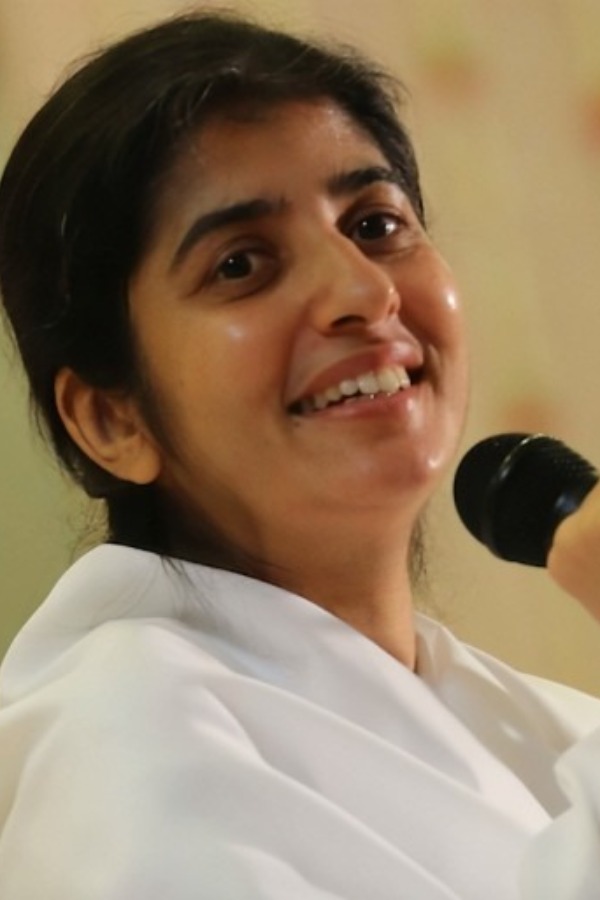
10 Quotes By BK Shivani For Students

Optical Illusion: Spot The Guests With Empty Drink Glasses

Read This If You Struggle With A Painful Relationship
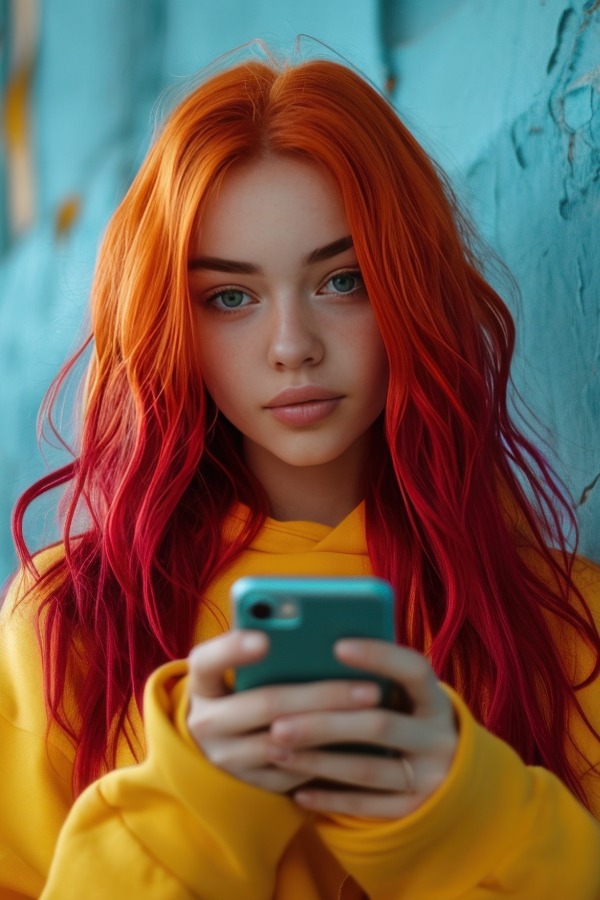
From 'Freckling' To 'Cuffing': Guide To Gen Z's Quirky Love Lingo

Top 10 Safest Cars In India With Global NCAP Rating 2024

Movies Of Samantha Ruth Prabhu’s Dubbed In Hindi

Only Genius Can Spot The Sewing Machine In 7 Seconds

10 Heart-Touching Shayari By Zakir Khan On Love

Only Genius With Sharp Eyes Can Spot The Three Differences

Chant This Powerful Mantras To Get Succes

Dream11 Team Today, CSK vs SRH, Match 47 IPL 2024 Team Prediction

Aamir Khan Reveals 7 Things He Has Not Said Before

Career In AI: Tier 2, 3 Cities Lead AI Job Growth & Jaipur Tops, As Per Report

Has Tiger Shroff Undergone Plastic Surgeries? Internet Wonders
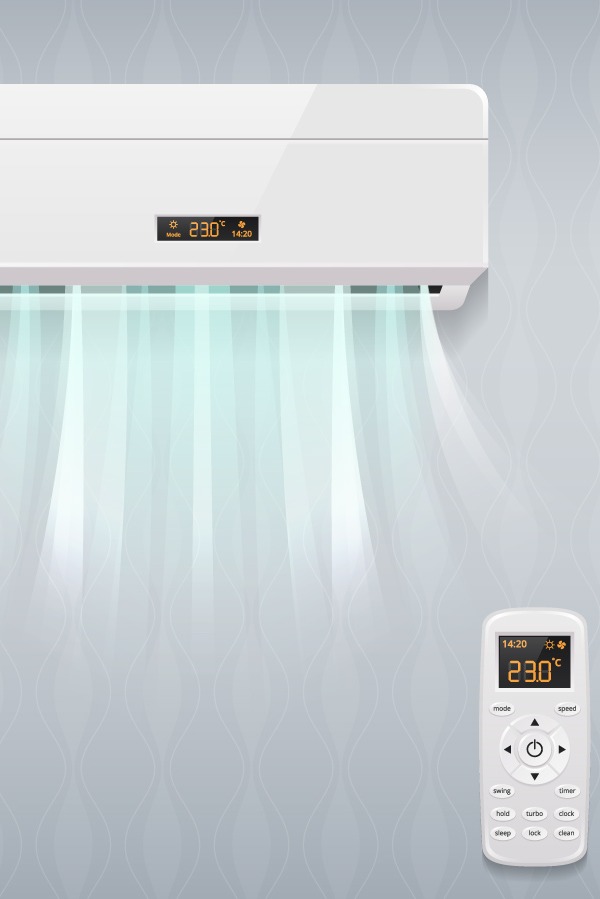
Best ACs Under 25000: Top Air Conditioners In India To Beat The Heat In Budget

DBS Bank, CRISIL 'Women And Finance' Report! Salaried Women See Pay Gap

Samsung Tab S9 Played Matchmaker For Art, Tales & Tech At Jaipur Lit Fest 2024

Samsung's Jaw Dropping New Release! Gadget Or Fashion Icon? You Decide!

Beauty Beyond Looks- Femina & Mamaearth Honor Kindness At Beautiful Indians 2024

Weather The Storm With OnePlus 12R! Durability Meets Ultimate Performance
Accept the updated privacy & cookie policy.

IMAGES
COMMENTS
Northern Lights in March Best time of the year to see Northern Lights. Temperatures begin to increase in March, but it can still be chilly, especially at night. The ground is covered in a deep, clean coating of snow, and because most of the winter snow has fallen, there are fewer snow clouds overhead to obscure the Northern lights in March.
When are the best times of the year to see the northern lights? Talk to anyone in the "aurora zone" — on the Arctic Circle — and they'll report seeing them even in August and May. However, the ...
Located about 220 miles above the Arctic Circle, Tromsø is one of several top spots to view the northern lights in Norway. At the darkest point of the aurora season - which runs from September ...
The best time to see the northern lights in Alaska is from late August to mid-April, when the nights are long and dark. (You won't see them during the summer months because of Alaska's midnight sun.) Plan to look for the spectacular, multi-colored lights from 11 p.m. to 2 a.m., when the sky is at its darkest and the auroras are the most active.
Best Time to See the Northern Lights in Alaska. Alaska's northern lights season is between late August and late April, peaking in March. However, the season is defined more by its long, dark ...
According to the Alaska Travel Industry Association, the best time to see the northern lights is typically from Aug. 21 to April 21, also known as the Aurora Season. While the aurora can appear at ...
Canada is an aurora viewing paradise, thanks to its northern latitude and low light pollution; elsewhere in the country, Wood Buffalo and Jasper National Park are popular viewing spots. When to Go ...
In summary, the best time to see the Northern Lights is from 10:00 to 2:00 on clear nights from the fall to the early spring, with September and March as the best months in terms of solar activity. However, there are some factors like darkness, clear skies, and solar activity that will vary depending on your location.
All combined these variables make the Fairbanks region an outstanding destination for possible aurora borealis viewing. When is the best time to see the northern lights? Fairbanks' Aurora Season is from August 21 to April 21 and the aurora will be visible in Fairbanks an average of four out of five nights when the sky is clear and dark enough.
When to see the northern lights. If you're planning an aurora-viewing trip, the best time is throughout the winter months. Anytime between late September to late March is a good time for northern ...
The strongest lights tend to appear between 9pm and 2am, though the best sightings often occur between 11pm and midnight. Between 4am and 5pm there is generally too much daylight to see the aurora - exceptions are the darkest months of the year and higher latitudes such Svalbard, where it is dark 24/7 from mid-Nov to end of Jan.
The best time to see the aurora borealis in Alaska is from August 21 to April 21. We call it the Aurora Season. So yes, there are some very lucky cruise passengers who will see the northern lights in the Inside Passage late in the summer and fall, but don't bank on it. Southeast Alaska is a temperate rain forest, so precipitation and cloudy ...
If you have a goal of seeing the aurora borealis in any of the destinations discussed here, you're best off booking as far into the fall as you can find a cruise. Norway is the only prime northern lights destination with winter cruises. The lights like to appear in the wee hours — particularly between 11 p.m. and 3 a.m. — in Alaska.
The Northern Lights are more prevalent during Solar Maximum, the last of which occurred in June 2014. Generally speaking, the Aurora Borealis will remain very active for two to three years either side of Solar Maximum which effectively means we're heading into the period of maximum activity. There is further research to suggest that more ...
Girdwood. If you have a car, head away from town to a spot away from ambient light with unobstructed views of the sky. Here are some of the best spots for northern lights viewing in Alaska: Anchorage: Glen Alps trailhead, Point Woronzof. Girdwood: Moose Meadows. Talkeetna: Riverfront Park, Denali State Park.
The best places to see the northern lights are in the auroral zone—a 1,500-mile radius of the north pole. But during geomagnetic storms (more on that below), this fantastical light display can move southward and be visible throughout the Midwest. Those in North Dakota, Minnesota, Wisconsin and Michigan have the best chances, but this magical ...
Scotland. Getty Images. The aurora can be seen across the U.K., as far south as England's Kent and East Anglia, in the autumn and winter months. But the best bet is to head for the northernmost ...
Best time to see the Northern Lights in Fairbanks. The best time to see the Northern Lights in Fairbanks, otherwise known as Fairbanks' official aurora season, is from late August to late April. Unfortunately, throughout the rest of the year, there's not enough darkness to see the aurora properly. Best time to see the Northern Lights in ...
The best time of the year to see the northern lights in Iceland is undoubtedly the winter months. However, throughout these months, Iceland endures its worst weather. Clouds can block the sky, and therefore the aurora borealis, for weeks at a time. Storms are also more common this season, occasionally leading to the cancellation of tours or the ...
Getty Images. According to the country's tourism authority, the best time to see the northern lights in Iceland is from September to mid-April, between 9 p.m. and 2 a.m. - and particularly ...
1. The light show appears when charged particles from the sun are dragged into the atmosphere by the earth's magnetic field and collide with nitrogen and oxygen atoms. This collision releases flashes of coloured lights - which we see as the northern lights. 2. The colour of the light depends on the type of atoms involved in the collision. 3.
The best time to view the Aurora Borealis in Fairbanks is between August 21 and April 21. Travelers can check out Borealis Basecamp for a private igloo, one of the Fairbanks' top glamping resorts.
Solar Maximum - when bright colours and regular sightings of the Northern Lights are common - is predicted to happen midway through this cycle, most likely around July 2025. Meanwhile, if you fancy experiencing the Midnight Sun when you're there, head north between the summer months of May and July. During the summer solstice, the sun ...
Across Canada's northern skies, the best chances to see the Northern Lights are between late August through April. Autumn and early winter mean long, dark nights. The cold weather also brings a higher chance of clear skies in northern latitudes — ideal for aurora viewing. Our local experts have put together this guide to the best times and ...
Where To Chase the Northern Lights. The aurora borealis is typically visible anywhere across the Arctic Circle (approx. 66 degrees north). But a few destinations have captured travelers' imaginations for their access to the late-night lights and more. Expedia reports triple-digit year-over-year increases to popular northern lights destinations.
1. The light show appears when charged particles from the sun are dragged into the atmosphere by the earth's magnetic field and collide with nitrogen and oxygen atoms. This collision releases flashes of coloured lights - which we see as the northern lights. 2. The colour of the light depends on the type of atoms involved in the collision.
Head north for a once-in-a-lifetime show. Northern Lights are most visible from the end of August to April in northern Finland. Auroras, caused by solar winds, occur year-round but the nights need to be dark enough for us to be able to catch a glimpse of this phenomenal light show. That is why autumn, winter, and spring are the best times to ...
Astronomers say 2024 will be a great year to see the northern lights. Stacker used various sources to list 10 places in the U.S. to view them. Astronomers predict this year will be the best in the ...
From Australia to New Zealand and Antarctica, these are the best places to view the spectacular celestial display known as the Southern Lights: the aurora australis. The Southern Hemisphere's greatest light show is often overshadowed by its northern counterpart, but the aurora australis is just as impressive as the borealis.
The city's position directly beneath the auroral oval makes it one of the best places in the world to see the Northern Lights. Visitors can embark on guided aurora tours, explore the pristine wilderness, and even stay in cozy glass igloos for an unforgettable aurora-viewing experience. 4) Fairbanks, Alaska